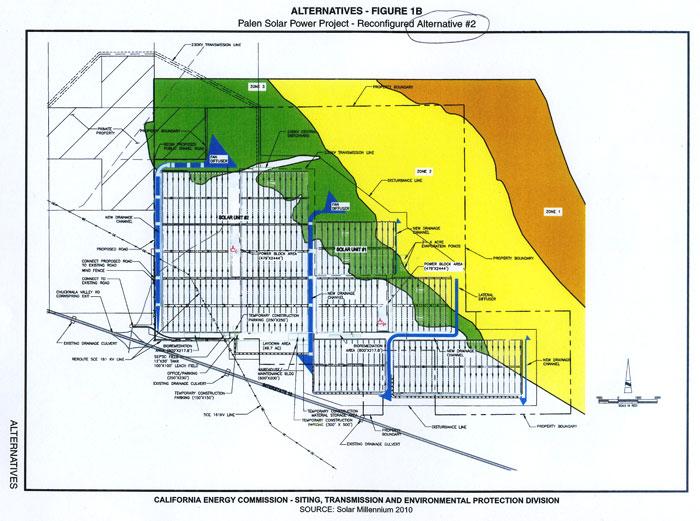Palen Solar Project Final Environmental Impact Statement Out
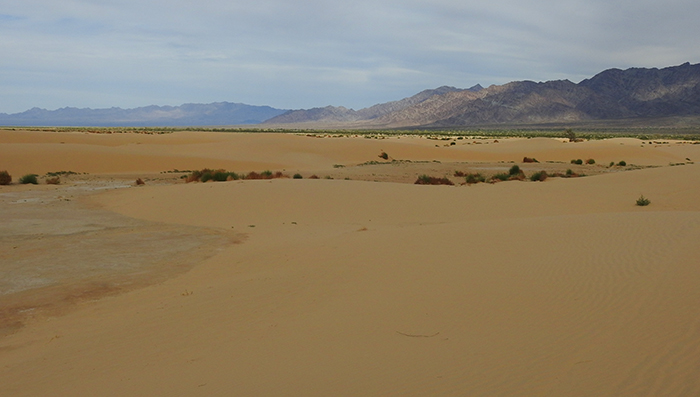
^Palen Dunes.
May 18, 2018 - Chuckwalla Valley CA - The Bureau of Land Management (BLM) announced the availability of the Final Supplemental Environmental Impact Statement and Environmental Impact Report and California Desert Conservation Area Land Use Plan Amendment for the proposed Palen Photovoltaic Solar Project in Riverside County.
The massive utilit-scale project would be 500 megawatts. There's just one problem: no storage. Other large-scale solar projects are integrating battery storage on site, such as the Crimson Solar Project proposed for nearby eastern Chuckwalla Valley. The increasing overgeneration problem in California is forcing the California Independent System Operator to look for other options in an attempt to balance the grid: use of hydropower, long transmission lines to high-quality wind areas in the Great Plains, time of use charges, and storage.
Yet this large-scale solar proposal offers nothing. What will the impacts be to ratepayers and the California grid?
BLM says, "The Palen Solar Project is consistent with the Trump Administration’s priority of pursuing energy independence, while improving infrastructure and creating jobs in local economies."
The Notice of Availability for the Final SEIS/EIR and proposed LUPA will publish in the Federal Register on May 21 and opens a 30-day protest period as well as a governor’s consistency review.
Our Comment Letter to BLM
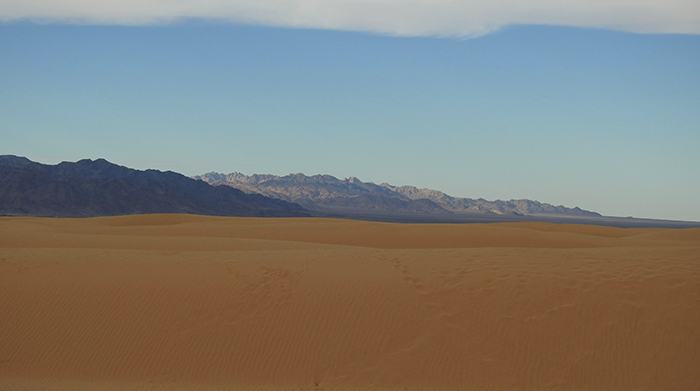
^The Palen Dunes.
December 10, 2017 - Basin and Range Watch
To: Bureau of Land Management
Palm Springs - South Coast Field Office
1201 Bird Center Drive
Palm Springs, California 92262
Email sent to: palensolar@blm.gov
Subject: Comments on the Draft Supplemental Environmental Impact Statement for the proposed Palen Solar Power Project DOI-BLM-CA-060-2017-001-EIS
Basin and Range Watch is a 501(c)(3) non-profit working to conserve the deserts of Nevada and California and to educate the public about the diversity of life, culture, and history of the ecosystems and wild lands of the desert. Federal and many state agencies are seeking to open up millions of acres of unspoiled habitat and public land in our region to energy development. Our goal is to identify the problems of energy sprawl and find solutions that will preserve our natural ecosystems, open spaces, and quality of life for local communities. We support energy efficiency, better rooftop solar policy, and
distributed generation/storage alternatives, as well as local, state and national planning for wise energy and land use following the principles of conservation biology. We have visited the site of the Palen Solar Project 5 times.
Basin and Range Watch has followed and opposed all proposals to build a solar project near the Palen Dry Lake since 2009. Although different development plans and configurations have improved over the last 8 years, the impacts to the environment would be un-mitigable. The project is now a photovoltaic project and this EIS is attempting to say that is a lower impact project, but we will list why a large PV
project would also be unacceptable in this location. The project location lies in both a Solar Energy Zone (Western Solar Plan) and a Development Focus Area (Desert Renewable Energy Conservation Plan, however, the project history predates both of those plans. Because the project would have many significant environmental impacts, the Bureau of Land Management (BLM) can by-pass those plans for better conservation management in this region. Furthermore, the Desert Renewable Energy Conservation Plan (DRECP) only makes recommendations and the BLM is not required to follow the
Development Focus recommendation for this region. One very major flaw of the DRECP in this region is to recommend that the sand transport corridor be left alone, yet the simultaneously the DRECP designated Develop Focus Areas on most of this transport corridor.
Basin and Range Watch has the following comments on the subjects reviewed by the BLM Supplemental Environmental Impact Statement for the BLM and the Environmental Impact Review for Riverside County, California. Basin and Range Watch can only support a No Action Alternative.
Purpose and Need Statement
The BLM Purpose and Need Statement cites Executive and Secretarial Orders that really are not required to be specific to this project and this plan does not fulfill all the requirements in the orders.
EO 13212 mandates transmission of energy in a “safe and environmentally sound manner”. But this EIS/EIR is full of short comings and does not protect the environment or public health (due to fugitive dust).
SO 3285A1 is from 2010 and establishes the development of renewable energy as a priority for the DOI, but it never says how much of that goal has been fulfilled since 2010. Thousands of megawatts of renewable energy have already been built on public lands. Too much solar energy may have now been built on public lands in the state, over-loading the grid (see below). This order also does not specifically say that the location of the Palen Project is required to meet this goal.
The Memorandum of Understanding between California and the DOI is for California Orders AB32 and SBX2. AB 32 requires California to reduce its GHG emissions to 1990 levels by 2020. These orders do not require the renewable energy to come from the Palen site or even from public lands in general. These goals could be fulfilled with built environment alternatives and brownfield alternatives.
Competitive Processes, Terms and Conditions for Leasing Public Lands for Solar and Wind Energy Development – While this is for all public lands, it was really designed for Solar Energy Zones and similar designations. The Palen Solar Project application predates the Western Solar Plan and there are no requirements for the BLM to approve a project based on these orders.
We request that the Purpose and Need statement be rewritten to emphasize BLM’s commitments to protect valuable resources. A solar project of this size cannot avoid impacts to important resources.
The project is home to BLM Sensitive Species. The Mojave fringe-toed lizard and the Harwood’s milkvetch are two BLM Sensitive Species. The BLM is required to protect BLM Sensitive Species as defined in BLM Manual 6840 (Special Status Species Management).
The objectives of the BLM sensitive species policy are twofold, as follows:
1. To conserve or recover species listed under the Endangered Species Act of 1973 (ESA; 16 USC, Section 1531 et seq.), as amended, and the ecosystems on which they depend so that ESA protections are no longer needed for these species
2. To initiate proactive conservation measures that reduce or eliminate threats to BLM sensitive species to minimize the likelihood of and need for listing of these species under the ESA
The Palen Solar Project site also will potentially impact species protected under the Endangered Species Act. These species include the Desert tortoise and the Yuma clapper rail. The BLM has a commitment to follow guideline of the Endangered Species Act. Signed into law in 1973, the original goal of the Endangered Species Act (ESA) was to preserve and recover key domestic species from the brink of
extinction.
Resources on the site are also protected by the Archeological Resources Protection Act of 1979. This statute (16 U.S.C. 470aa-470mm; Public Law 96-95 and amendments to it) was enacted
...to secure, for the present and future benefit of the American people, the protection of archaeological resources and sites which are on public lands and Indian lands, and to foster increased cooperation and exchange of information between governmental authorities, the professional archaeological community, and private individuals.
The Migratory Bird Treaty Act of 1918 was an Establishment of a Federal prohibition, unless permitted by regulations, to "pursue, hunt, take, capture, kill, attempt to take, capture or kill, possess, offer for sale, sell, offer to purchase, purchase, deliver for shipment, ship, cause to be shipped, deliver for transportation, transport, cause to be transported, carry, or cause to be carried by any means whatever, receive for shipment, transportation or carriage, or export, at any time, or in any manner, any migratory
bird, included in the terms of this Convention . . . for the protection of migratory birds . . . or any part, nest, or egg of any such bird." (16 U.S.C. 703)
Land Use Plan/ The California Desert Conservation Area: The lands lie under the FLPMA approved California Desert Conservation Area. The region is designated as Class M which is designated for a “controlled balance between higher intensity use and protection” A variety of uses are listed in this class and the problem is that designating up to 6 square miles as a Right of Way for ONLY solar energy is inconsistent with Class M (Moderate Use) designation. The solar project would be more appropriate on
lands with Class I (Intensive Use) designation – that is “lands managed for concentrated use to meet human needs”.
We request that the Purpose and Need Statement for the SEIS analyze the above conservation policies. The statement now is biased towards approval of renewable energy which does not reflect the wishes of all of the involved stakeholders in this project.
The Over-generation Problem in California Due to Large-scale Solar Projects
The Need for this project is questionable, as it adds a large cumulative impact to grid congestion in California. The state is currently experiencing a worsening glut of solar power at peak times on the transmission grid system. This has been shown as the Duck Curve, where renewable energy generation exceeds demand in the middle of the day, then causing the need to ramp up generation at the end of the day after the sun sets with inefficient natural as peaker plants. At times, as much as 13,000 MW is needed in 3 hours in the evening hours, as solar projects go offline at night.
The California Independent System Operator (CaISO) states: “In almost all cases, oversupply is a manageable condition but it is not a sustainable condition over time — and this drives the need for proactive policies and actions to avoid the situation.”
(http://www.caiso.com/Documents/FlexibleResourcesHelpRenewables_FastFacts.pdf)
Adding yet another large-scale solar project onto the grid would not be in the public good, and further push the over-generation problem into a high-risk situation, instead of solving the problem with such solutions as rooftop solar systems paired with local storage in improved net-energy metering.
The problem is currently being managed by the wasteful and highly inefficient means of “curtailment.” CaISO states, “Curtailment is an operational tool that works well in today's energy market. But as the state introduces increasing amounts of renewable resources, oversupply conditions are expected to occur more often. The ISO is seeking solutions to avoid or reduce the amount of curtailment of renewable power sources thus enabling the state to maximize the use of clean energy sources.” Curtailment charts show that in April of 2017, over 80,000 MWh of generation had to be shut off to
keep the grid balanced - (http://www.caiso.com/informed/Pages/ManagingOversupply.aspx).
The total solar and wind energy curtailment amount for 2017 year-to-date as of December 8, 2017, was 367,651 MWh (http://www.caiso.com/Documents/Wind_SolarReal-TimeDispatchCurtailmentReportDec08_2017.pdf). This is an incredibly wasteful land use for energy sprawl that has converted diverse ecosystems and cultural resources into what will apparently be an only partially-functional energy generating project.
An article in Mother Nature Network, June 26, 2017 summarized even more problems hoisted onto the state grid.
For the first quarter of 2017, California spent millions paying Arizona utilities to take its excess solar. In March alone, there were 14 days when the state exported its solar production, including a record-setting stint on March 11 from which 40 percent of the state's electricity came from utility-scale solar generation. While this so-called "negative pricing" eases during the summer months when consumer demand for electricity increases by more than half, [Ivan] Penn reports that the pay-off trend will only
increase in the coming years as more solar projects come online.
How much of the Palen Solar Project energy will simply have to be curtailed after the project is built, or sold to other states? California is showing the stresses of trying to achieve a 50% Renewable Energy Portfolio without better planning, adding utility-scale projects willy-nilly instead of re-organizing the proportion of renewable energy sources that come from Distributed Energy Resources (including residential battery storage paired with rooftop solar panels)—that could help alleviate the grid problems by load-shifting energy generated with solar during the day, and using it at night, instead of ramping up fossil fuel power plants.
Proposed Action, Alternatives and Environmental Consequences
Basin and Range Watch has reviewed the proposed action and all alternatives. We have concluded that the No Action Alternative is the most sensible for this project due to the great impacts it would cause. The continuing changes to this project and converting it to photovoltaic have not eliminated major conflicts involving hydrology, biological resources, cultural resources, visual resources, air quality and alternatives.
The Proposed Action and the two Development Alternatives
What will the photovoltaic panels be made from? Thin-film, cadmium teluride? Crystalline silicon? Copper Indium Gallium Selenide?
It would be helpful to know this during the review process because the texture of the panels could be instrumental in attracting birds to the lake effect produced by solar panels.
Water Use for Construction and Groundwater Hydrology
The propose action states that the water use for construction would be 497 to 700 acre feet of water per year. That is a gap of 203 acre feet that is not being calculated. The Desert Sunlight Solar project to the east was approved by BLM to use 1,507 acre feet of water for construction. That went up after the original approval of 1,407 acre feet. In 2014, the developer requested to use an additional 50 acre feet to complete construction of the project and transmission hookups. The BLM approved this even though the USGS stated that the water comes from a fossil aquifer and would not be recharged.
USGS conducted a study in the Chuckwalla Valley, Groundwater Ambient Monitoring Analyzing or “GAMA”, which provided age dating for the area. Mr. Michael Wright, USGS, (an author to the study) examined wells in Desert Center and determined the water is “very, very old”, thousands of years old. He explained if tritium is not detected there has been no recharge for the past 50 years, which is a commonly accepted hydrological fact. There is no tritium analysis in the SEIS. The link to the GAMA study is here: http://pubs.usgs.gov/ds/659/
The request and need to use additional water for large desert construction projects is common. Low humidity paired with extreme temperature creates a perfect storm for fugitive dust and the developer First solar had trouble keeping their water use down to what the BLM had originally authorized. This will most likely be the case for the Palen Solar Project as well. The development of huge solar projects in the region has already used quite a bit of water. The proposal to build the Eagle Crest Pumped Storage project 20 miles to the west will also add a cumulative impact to the overall needed water for this project. The SEIS should do a cumulative future analysis of all of the water that is proposed to be used for green energy in this region.
Since the project would use 51 wells located near Desert Center, California, we think that the Palen Solar Project will use fossil groundwater in the region.
The project would use up to 10 on-site groundwater wells.
We are concerned about groundwater pumping to phreatophytes, arid-adapted trees with deep roots to access groundwater. Honey mesquite groves (Prosopis glandulosa) surround much of Palen Dry lake about a mile from the proposed project. Other deep-rooted desert trees in the area include Ironwood (Olneya tesota), blue palo verde (Parkinsonia florida), and smoke tree (Psorothamnus spinosus).
A special Natural Community, the Alkali Sink Scrub, is even more endangered because the shrubs have shallower roots. This community is dominated by Iodine bush (Allenrolfea occidentalis) and Bush seepweed (Suaeda moquinii). These are wetland indicators of playa depressions with a shallow aquifer.
Groundwater monitoring should be part of the project's Monitoring Program to check if phreatophytes are dying due to a lowering of the groundwater table. The BLM should consider an alternative that requires EDF to haul all of their water in for the project.
Surface Hydrology
Much of the final engineering and design of the Erosion Control and Stormwater Drainage plans are deferred until after approval, and so the public has no good idea of exactly how the project will withstand the intense flash floods that regularly inundate Chuckwalla Valley.
For instance, the SEIS says on page 2-9, that the "the use of retention basins would be determined with final engineering with up to six retention ponds possible at key locations..." and "Control structures, such as small earthen berms and swales, would likely be used to protect the solar block installations."
Impacts to the other large solar projects in the area (Genesis Solar Energy Project and Desert Sunlight Solar Farm) from flooding has led to much new information about how these projects impact desert landscapes, and this has never been evaluated. Simple having an Alternative that purports to avoid one wash does not analyze how chaotic braided-stream type floodwaters may flow through the project footprint during intense storm events that regularly occur in the Colorado Desert.
In July-August, 2012 a huge flash flood, typical of the Colorado Desert, hit the Genesis Solar Energy Project. The damage was described as "massive".
Pylons for the trough mirrors were knocked over, foundations uprooted, whole erosion terraces were overwhelmed and are gone. There is an estimated tens of millions of dollars-worth of damage to the solar thermal project.
Again, between August 22nd and August 25th, 2013, numerous rain events occurred in the Chuckwalla Valley. These events led to onsite damage at the Genesis Solar Energy Project including standing water within the site and access road areas; damage to perimeter security and desert tortoise fencing; breaching of several levees; improper functioning of detention basins resulting in concentrated water flows and erosion; along with offsite flows in several other areas where the storm water drainage system was inadequate to channel runoff as designed.
Concrete Batch Plant
The project will be required to have a 2 acre concrete batch plant for construction. While the goal of the project is to reduce GHG emissions, it should be noted that concrete is very C02 intensive to produce. As much as 10 percent of global CO2 emissions come from the production of concrete. Utilizing solar energy through Distributed Generation as an alternative would eliminate much of this carbon footprint because much if that environment is already built.
Gen-Tie Line
The 6.7-mile gen-tie transmission line to the Red Bluff Substation will impact biological, cultural and visual resources. Construction of the line will also cumulatively add to the fugitive dust/air quality problems this project will create.
The line will destroy Mojave fringe-toed lizards and their habitat. The line will also cause bird mortality. Power lines electrocute birds and kill them on impact. Migrating birds flying at heights below 50m have a significant collision risk. Moreover, species that congregate in large flocks are more vulnerable to collisions than solitary species. This will add to the cumulative impacts of all the other energy projects built in the region. The SEIS should provide an estimate of how many birds would be killed by the new
transmission line.
The new line will also be visible from the Palen-McCoy Wilderness area, the Chuckwalla Wilderness Area, the Desert Lily Preserve and the Palen Dry Lake Area of Critical Environmental Concern.
Start of Construction
The SEIS states that the construction schedule would begin in the fourth quarter of 2017 which would be impossible as it is December 8th when this is being written.
Grading, Vegetation Removal, and Treatment
The SEIS states that the site would use “drive and crush” and not grading when feasible but does not list a percentage of land on the site where this mitigation would be deployed. How much of the site would use the drive and crush method?
Invasive weeds would be controlled using herbicides and pesticides, but you have not listed which herbicides would be used. Many of the approved herbicides like Glyphosate and Plateau can cause health problems with people. It is alarming that potentially 6 square miles would be treated with herbicides.
A No Herbicide Alternative should be considered.
Cultural Resources
From the beginning, Native Americans representing Colorado River Tribes have been opposing all configurations of this project. They have not wanted mitigation, money or any compensation for the project. The region is part of their traditional values. We learned that the June 2016 meeting that an additional significant site was discovered recently near the proposed project site.
Nearly all of the sites recorded in the area as prehistoric have been described as having potential for subsurface manifestation. In addition to their individual research potential properties, the distribution of many of these sites in conjunction with other prehistoric sites recorded between Desert Center and Blythe may provide links between vestiges of the Coco-Maricopa trail system as well as clues to activities associated with transportation along that route. As such, these sites could be considered as part of a
complex archaeological district that would include evidence of trade, travel, interaction among the several cultural groups associated with the area (Cahuilla, Chemehuevi, Mojave, Serrano), resource use along travel routes, seasonality of habitation, and trail spurs between the primary coastal-interior route and the springs and associated rock art sites in the bordering mountain ranges. This is a Cultural Landscape that requires much better description, analysis and consultation with Native people.
The playa edges, benches, and washes contain a very high level of archaeological remains and features, including ancient trail systems (USFWS 2014).
Burial sites, bones and a whole village site were destroyed because Nextera did not do adequate enough surveys. This is not acceptable.
The BLM cannot mitigate these issues. Approval of this project will only make this situation worse.
Visual Resources
The Bureau of Land Management is evaluating the site based on Class III Visual Resource Management standards (VRM III).
USFWS in 2014 recommended under comments to the DRECP that:
Objective: Because of the proximity to Joshua Tree National Park, the area will be managed as VRM Class II. Some portions along the southern end managed as Class III.
VRM Class III Objective: To partially retain the existing character of the landscape. Allowed Level of Change: The level of change to the characteristic landscape should be moderate. Management activities may attract attention, but should not dominate the view of the casual observer. Changes should repeat the basic elements found in the predominant natural features of the characteristic landscape.
Although the Chuckwalla Valley has seen a large percentage of development, it remains a large area and the area surrounding the Palen Dry Lake is visually and topographically isolated.
From the proposed project site, visual impacts are there, but low. The Interstate 10 can be seen as well as some transmission lines, but the Desert Sunlight Project to the west is barely visible and the Genesis Project to the east is not visible at all from the Palen Solar Project site. While other parts of the Chuckwalla Valley have been visually impacted, this site is still visually “intact”. Development of up to 6 square miles of solar panels will create huge visual impacts. Even the Avoidance Alternative would create a 2 to 2 and ½ square mile visual impact.
VRM Class I Objective: To preserve the existing character of the landscape. Allowed Level of Change: This class provides for natural ecological changes; however, it does not preclude very limited management activity. The level of change to the characteristic landscape should be very low and must not attract attention.
VRM Class II Objective: To retain the existing character of the landscape. Allowed Level of Change: The level of change to the characteristic landscape should be low. Management activities may be seen, but should not attract the attention of the casual observer. Any changes must repeat the basic elements of form, line, color, and texture found in the predominant natural features of the characteristic landscape.
We would also like to see more Key Observation Point simulations. We would like to request a night lighting KOP and we would also like to request a KOP from the Wilderness area of Joshua Tree National Park. Since you can see the Coxcomb Mountains from the project site, it is obvious that the project site would be visible from the Coxcomb Mountains in Joshua Tree National Park.
Biological Resources
We have visited the project site 5 different times and have documented rich biological diversity. Even in November of 2017, the project site was undergoing a healthy wildflower bloom.
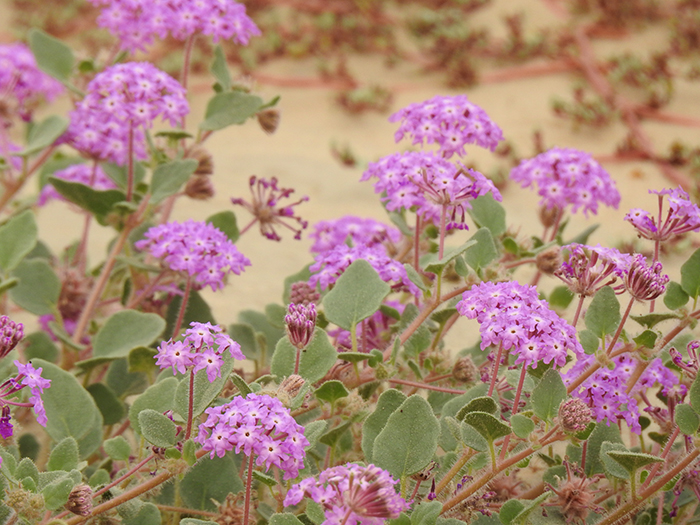
Palen Solar Project site, November, 2017 – location of the “Avoidance Alternative”: sand verbena (Abronia villosa) in full bloom. This would be graded and "drive and crush" construction methods used.
The project site is located on a sand sheet above and beyond the Sand Transport Corridor, and contains a number of unique species.
Biological Soil Crust
We found biological soil crusts on the Palen proposed project site on desert soils. What are the impacts of destroying these carbon-absorbing living soil communities?
On page 2-14, the EIS says "When feasible, construction activities will implement drive and crush rather than grading." This is highly destructive to sensitive biological soil crusts, as well as rare plants, and fossorial animal species such as kangaroo rats, pocket mice, burrowing owls, kit foxes, rattlesnakes, tarantulas, and desert tortoises. This is one of the more significant negative impacts of the project, and why we support a Distributed Generation Solar Alternative utilizing rooftop solar and parking lot solar
structures, in order to avoid this needless ground disturbance of the Colorado Desert.
Rare Plants and Natural Communities
The Avoidance Alternative would have CMAs requirements that actually would lead to many “holes” in the solar field, much more on the upland desert part of the project footprint, due to the required avoidance and setbacks of ancient old growth creosote rings and rare plants such as Harwood’s eriastrum. These setbacks have never been demonstrated to actually conserve plant species. The more ecological alternative would be the No Action Alternative, and a more efficient placement of solar panels would be in the built environment on rooftops.
DRECP-protected Natural Communities:
1. Aeolian sand transport system: this may include more the the project footprints than the EIS indicates. It should be better surveyed and assessed before approval. The sand transport system is wider than mapped in the EIS, from our field visits.
2. A Rare Alliance that needs investigation is a newly discovered saltbush (Atriplex sp.,
undescribed), found on the edges of Palen Dry Lake. What will the indirect effects be on this Natural Community from the project?
An earlier USFWS Worksheet on the DRECP recommends these rare alliances receive protection with an ACEC. But many of these are also present on the solar project proposal and have not been analyzed.
Rare Vegetation Alliances:
1. lodinebush Shrubland (Allenrolfea occidentalis) Shrubland Alliance
2. Spinescale Shrubland (Atriplex spinifera) Shrubland Alliance
3. Honey Mesquite Shrubland (Prosopis glandulosa) Shrubland Alliance
4. Bush Seepweed Shrubland (Suaeda moquinii) Shrubland Alliance
5. Big Galleta Herbaceous (Pleuraphis rigida) Herbaceous Alliance
6. Spectacle Fruit Herbaceous (Wislizenia refracta) Herbaceous Unique Stands
7. Blue Palo verde ‐ Desert Ironwood Woodland (Parkinsonia florida ‐ Olneya tesota) Woodland Alliance

^Large bunches of Big galleta grass in a wash on the proposed project site (all alternative footprints). This alliance was not analuzed, and would be bulldozed and driven over. Creosote and palo verde trees would also be trampled and uprooted for a solar array that could go on rooftops.
Desert tortoise
With such a large cumulative impact of solar projects within the Colorado Desert Recovery Unit for desert tortoise, is there enough land that can be acquired at a 5:1 mitigation ratio to truly compensate for destruction of habitat by the project? A similar question can be asked for Mojave fringe-toed lizard sand habitats. The wash left by the Reduced Footprint Alternative may not be wide enough to maintain genetic connectivity and movement of desert tortoise between the Chuckwalla ACEC Critical Habitat to
the south, and habitats to the north.
Mojave fringe-toed lizards
All three development alternatives will impact this species. The SEIS has developed an Avoidance Alternative which would allow no development on what has been determined to be the sand transport corridor to maintain sand flow which would maintain the major sand habitats in the Chuckwalla Valley. While this is a better alternative, the fact remains that the entire site is habitat for Mojave fringe-toed lizards (MFTL). We have spent a few days on the site in April and June and found that MFTL use most of the area for linkage. In areas where there is less fine-grained sand and more desert pavement, we saw MTFL moving in between sand hummocks which have blown up against several plants. This would mean that even the avoidance alternative is located in the sand transport to a certain extent.
The Avoidance Alternative does not insure that another solar developer could not apply for a Right of Way in the Sand Transport Corridor recognized by the DRECP. Fringe-toed lizards have been reduced or eliminated from small dune systems from off-road traffic and urban development in other areas, now this new threat faces these lizards.
How will new fence lines that provide perches for loggerhead shrikes that prey on lizards, be mitigated?
In 2010, the California Energy Commission stated in its Staff Assessment/Draft EIS"
Staff considers the direct, indirect, and cumulative direct effect of the Project to be significant for the Chuckwalla Valley Mojave fringe-toed lizard population. The cumulative impact of all the proposed projects would be to increase the already fragmented distribution of the Mojave fringe-toed lizards, and to increase the risk of extirpation of isolated populations within the Chuckwalla Valley. Staff's proposed Condition of Certification BIO-20 recommends acquisition and protection of core populations of Mojave fringe-toed lizard habitat elsewhere in the Chuckwalla Valley.
Habitat acquisition would offset some of this habitat loss, although not to less than significant levels, and cannot remedy the Project's interference with the sand transport process. Staff considers impacts of the Project, as currently configured, to be significant and unmitigable.
Mojave fringe-toed lizards will be killed by road work, blading of desert, and truck transport on new roads in the desert, as has already happened at a transmission line project nearby. Surveys along the Colorado River Substation access road associated with the Devers to Palo Verde 2 (DPV2) transmission line project in 2012 and 2013 showed a mortality rate of one fringe-toed lizard killed per day in the project construction area. According to a memo by HELIX Environmental Planning Inc., monitoring commenced in October 2012 at a rate of 6 days per week and ended in November 2012 when fringetoed
lizards were no longer active. Monitoring re-commenced in April 2013 at a rate of 5 days per week and ended in June 2013 when construction was completed in this portion of the project. HELIX relocated a total of 304 MFTL (40 in fall 2012 and 264 in spring/summer 2013) and recorded 90 MFTL mortalities (9 in fall 2012 and 81 in spring/summer 2013) during the two seasons of monitoring. In fall 2012, a total of 29 days of monitoring were conducted, which resulted in an average of 1.4 MFTL relocated/day and 0.3 MFTL mortalities/day. In spring 2013, a total of 61 days of monitoring were conducted, which
resulted in an average of 4.3 MFTL relocated/day and 1.3 MFTL mortalities/day.
Mortality of fringe-toed lizards is cumulatively building higher and higher in the Chuckwalla Valley due to this and other transmission line projects, associated substations, the Genesis solar project, Desert Sunlight and Desert Harvest solar projects, and the Palen solar project proposal.
The SEIS states that mitigation ratios would be 3 to 1. Where would these sand habitats be? How much private land containing this habitat would be available for purchase? Please list the locations and mitigations that are intended to compensate for the loss of so much of this habitat. The SEIS admits that it is uncertain if saving off site habitats will compensate for the loss of sand transport. We don’t believe that is possible.
We are surprised to read that clearance surveys would be conducted for MFTL before construction. We are not aware of any effective clearance surveys that have ever been conducted for this species. How would this be done? How possible is it to know where MTFL is under the ground or buried in the sand? At what temperatures would the surveys be conducted? How many lizards do you expect surveyors to find and do you believe that a clearance survey would adequately remove enough lizards to compensate for this massive development? How will MFTL be caught? Where will they be relocated to, and will these areas be subject to OHV impacts?
The SEIS has developed a plan for compensatory mitigation that would enhance and restore habitat elsewhere. Part of the plan is to “control unauthorized vehicle use in MFTL habitat”. There has been frequent off-highway-vehicle trespass on the Palen Dunes near the site. It appears that this has been going on un-monitored for a long time. We are concerned that these mitigations will not fully be implemented.
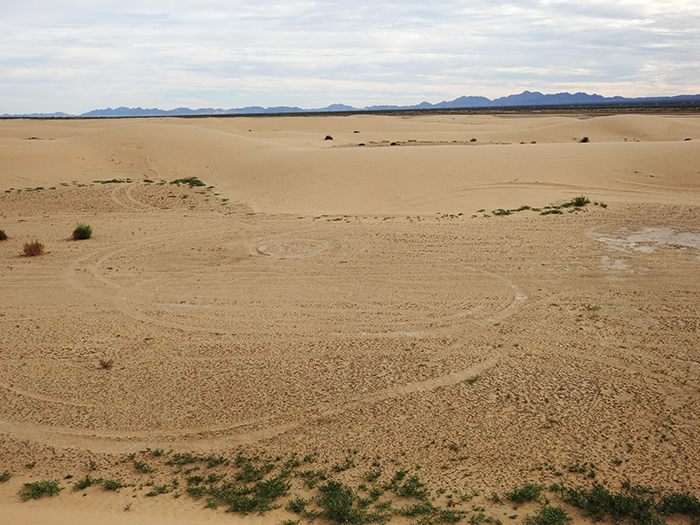
OHV tracks – Palen Dry Lake ACEC, November 2017
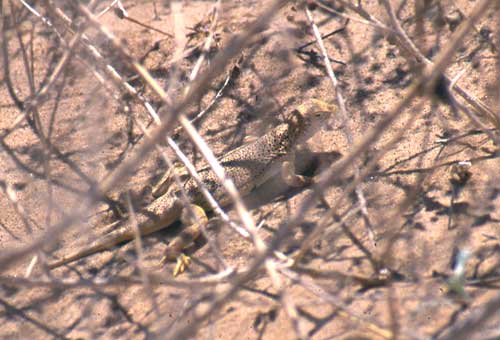
Mojave fringe-toed lizard seen on the Avoidance Alternative site. November, 2017
For Mojave fringe-toed lizard, as an adjunct to compensatory land acquisition, the project owner may elect to restore and enhance MTFL habitat in ACECs and /or California Desert National Conservation Lands (page 4.21-47). We have several questions about this: will habitat restoration take place in the adjacent Palen Ford Playa Dunes ACEC? We visited this area in November 2017 and found numerous OHV tracks on the dunes and flats between dunes. BLM may not have the budget to patrol the area enough to stop these incursions. How will the company ensure that OHV activity is prevented on the MFTL habitat? How will the public know that habitat restoration and enhancement is taking place, and is it successful? Or will these activities take place on habitat somewhere else in the California Desert? How will the public learn of this? Any restoration activities should take place in Chuckwalla Valley where the Mojave fringe-toed lizard population may be a unique genetic segment (Murphy, R. W., T. L. Trepanier, and D. J. Morafka. 2006. Conservation genetics, evolution and distinct population
segments of the Mojave fringe-toed lizard, Uma scoparia. Journal of Arid Environments 67: 226-247.). Monitoring reports should be made public.
Figure 3.15-1 shows a map revealing that the Sand Transport System supposedly avoided by the project, lies in a DRECP-designated Development Focus Area. In the future, another project proponent could come in and develop another solar project on this sand corridor adjacent to the Palen project, and having a large cumulative impact on Mojave fringe-toed lizards. This needs analysis in the present EIS.
An earlier draft a worksheet by USFWS for the DRECP described a proposed Palen-Ford Playa Dunes ACEC, which apparently became the Palen Dry Lake ACEC and Palen-
Ford ACEC in the later versions of the DRECP. The earlier version, Palen-Ford Playa Dunes, was described containing “extensive and pristine habitat for Mojave fringe-toed lizard,” a description that we believe applies equally well to the sand habitat on the proposed Project alternatives.
Avian Solar Interactions and Mortality
This has been a big problem for the renewable energy projects located in the Chuckwalla Valley. Two of the solar projects in particular, Desert Sunlight and Genesis have reported high numbers of avian mortality. In fact, Wally Erickson of West Biological Consulting made a presentation at the Technical Symposium on Avian-Solar Interactions called Regional Observations and Trends in Avian Monitoring and Mortality. In the presentation, he said that the Desert Sunlight Project has reported some of the larger avian mortality numbers.
Both the Desert Sunlight and Genesis Project have reported a diversity of birds that have become avian mortalities and many of the birds were detected to have collision injuries. The Palen Solar Project would be located in between the two in the Chuckwalla Valley.
The Solar Industry and some agency representatives have suggested that many of the birds would have died in these locations even if no solar project had been built there. But the Bureau of Land Management conducted a study on this subject and it was presented at the Technical Symposium.
Amy Fesnock of BLM gave a very interesting talk on her background avian mortality study. BLM decided to piggy-back avian mortality surveys onto desert tortoise line distance sampling, which has a long history of annually counting tortoises for recovery estimates, across the desert in a rigorous scientific fashion.
Fesnock came up with a brilliant way to have surveyors also look for any dead birds along these transects, to estimate background avian mortality in more natural areas of the desert, not disturbed by solar development.
Surveyors were trained to find carcasses placed out in the desert, and 97% of detections were within 10 meters of the line. So 10 meters was used as the effective sampling width.
Carcasses were placed out on desert sites to see how long they lasted. USGS Mathematician Manuela Husto applied statistical sampling techniques to the data and applied detection curves for large, medium, and small birds, and was able to estimate when carcasses would no longer be observable. 453 transects were walked by biologists from March to May in 2015, in the Fremont-Kramer Area of Critical Environmental Concern (ACEC), Superior-Cronese ACEC, Ord-Rodman ACEC, Joshua Tree National Park, the Pinto Mountains, Chuckwalla ACEC, and Chocolate Mountains. So these surveys covered a
huge swath of the California Desert with intensive surveys walking the ground searching the ground. Surveyors covered 37 square miles of relatively natural desert.
In all this survey effort, only 6 avian mortalities were found: one adult red-tailed hawk, apparently killed by a great-horned owl as it lay below an owl nest; one juvenile red-tailed hawk; one rock wren that was apparently predated by a loggerhead shrike, as it was preserved on a shrike perch impaled on a cactus; and three feather spots of unknown species.
This is far less than the avian mortality rate on solar projects. Some solar companies have implied that their bird mortality rate is not much greater than the natural background mortality rate in the desert, as before a project broke ground. But Fesnock's study refutes this strongly.
The desert background mortality rate determined from line distance sampling in 2015 was 0.024 birds/acre/year. This could be broken down further to 0.004 large birds/acre/year, 0.0026 medium-sized birds/acre/year, and 0.0214 small birds/acre/year.
But on three unnamed solar projects, Fesnock explained that the avian mortality rate increased to 1.7 birds/acre/year, 0.4 birds/acre/year, and 0.6 birds/acre/year.
Fesnock concluded, "When compared to mortality rates from solar projects, background mortality does not appear to be a significant factor and could easily be accounted in the sampling design error rates."
Accuracy of Reporting
While we believe that the biologists hired to survey these projects are highly qualified individuals, we question the accuracy of the reporting because we have been told some biologists have lost jobs over reporting information. Interestingly, this was backed up at the last Desert Tortoise Council Symposium in 2016. Kathryn Simon of Ironwood Consulting told everybody that the politics of management from the solar companies often get in the way of accurate reporting. In the Symposium Abstracts, she reported “the political backing that supports energy development in the western part of the country has also resulted in the neglect or abuse of natural resources. While a great deal of effort is placed on properly siting and permitting a project, little or no oversight happens once the project enters construction and continues into operations and maintenance. This has led to a “power vacuum,” often filled by the project proponent's "environmental" staff who often ensure the least amount of information leaves the project and is reported to wildlife agencies and the public. Specific examples of such behavior are provided and suggestions made for biologists on the ground in achieving their goals of proper monitoring oversight.”
Are we getting the entire story?
Focused vs. Incidental Surveys
The mortality numbers reported on the Genesis Solar Project to the east were much higher when the mortality finds were incidental (workers randomly finding bird mortality). Now that surveys are focused, the numbers appear to be about half of what they were. This raises the questions: Is mitigation working? And are mortalities not being reported?
The Numbers and Alarming Lack of Mitigation Ideas
For photovoltaic projects, avian mortality is caused by collision and possibly dehydration as birds are unable to fly away. A study on 7 California large-scale solar projects found that from 2012 to 2016, 3545 mortalities from 183 species were detected.
A diversity of species have been found including many water birds such as grebes, pelicans, ducks, coots and gulls to name a few. Special Status and Endangered Species include Yellow-billed Cuckoo, Yuma’s Ridgeway (clapper) rail and Willow flycatcher.
A dead Blue-footed booby was even found on one of the solar projects south of the Salton Sea in Imperial Valley.
The Lake Effect and Polarized Glare
One main theory is that the polarized light from solar panels may attract birds and insects to solar projects in the Mojave Desert (Horvath et al. 2009).
Does the light have to be polarized to attract birds? Could other factors such a texture, color and topographic features play a part?
We request that this important impact be studied more before any more of these giant projects are approved. Specifically: What is the mechanism of lake-effect, high polarized light pollution, chromatic, achromatic, glare, etc.?
When the mechanism is identified, predictions of specific species can be tested in the field by altering the solar configuration.
After that, data could be collected in the field to identify factors that may attract birds to solar projects.
It is also possible that BLM’s preferred Reduced Footprint Alternative that leaves a major wash with microphyll undeveloped may actually bait birds that would eventually hit solar panels. Only a No Action Alternative would avoid this possibility.
Because the proposed Palen Solar Project would be situated in a significant location for migrating birds in the Pacific Flyway, we believe that the cumulative impacts that the project will cause along with other solar projects in the region would not be worth the approval of the project.
Burrowing Owl
A Burrowing Owl Mitigation Plan should not be deferred, but be prepared now before project approval (page 4.21-11).
Desert Kit Fox
A system should be in place to pay for a kit fox monitoring plan to make sure another outbreak of canine distemper will not happen, as occurred at Genesis Solar Energy Project.
Desert Bighorn and Burro Deer
There is evidence of bighorn sheep in the Palen and Chuckwalla Mountains. Developing the site will potentially remove connectivity habitat for the species. Burro deer use the washes on the Palen site. Burro deer have a very limited habitat in California. They are endemic to Colorado Desert region in California. They are rare in the region and have lost additional habitat to other massive solar installations in the region. This also justifies a No Action Alternative.
Wildlife Connectivity Corridor
USFWS years ago recommended this area be managed as a 2-kilometer wide wildlife connectivity area, under a scenario of the No Action Alternative of the DRECP. This leads us to believe there is much greater wildlife genetic linkage value than is analyzed in the EIS:
No Action – this area would continue to be managed as a wildlife habitat management area. A connectivity corridor, at least 2 kilometers wide, will be designated crossing over/through the Solar Energy Zone that was designated in the Solar PEIS. This corridor will generally be in the vicinity of the Palen Dry Lake, but the specific location will be determined at the time that the Plan of Development and Project specific NEPA are prepared. This corridor would be managed to support and maintain wildlife
connectivity.
Air Quality/Fugitive Dust
We are also particularly concerned about the compromised air quality that will most likely result from the construction of this project.
The land rush of large solar projects all over the southwestern US has resulted in expedited approval of many of these projects. In most of the cases, the developers have not adequately mitigated the fugitive dust that has resulted in the removal of large acreages of vegetated desert lands.
Removal of stabilized soils and biological soil crust creates a destructive cycle of airborne particulates and erosion. As more stabilized soils are removed, blowing particulates from recently eroded areas act as abrasive catalysts that erode the remaining crusts thus resulting in more airborne particulates.
We are concerned that industrial construction in the region will compromise the air quality to the point where not only visual resources, but public health will be impacted.
We are also concerned that the applicant will have no choice but to use more water in an already overdrafted aquifer to control the large disturbance they intend to create.
Large solar projects in desert areas are very bad for air quality. Removal of stabilized soils and biological soil crust creates a destructive cycle of airborne particulates and erosion. As more stabilized soils are removed, blowing particulates from recently eroded areas act as abrasive catalysts that erode the remaining crusts thus resulting in more airborne particulates.
The Right of Way for the Desert Sunlight Project to the west guaranteed that mitigation would control fugitive dust emissions, but photos taken of the Desert Sunlight Project during initial construction show “dust blackouts” that have occurred when there are strong wind events. These dust blackouts were reported to be rare in the area before First Solar disturbed so much of the ground with large earth moving machines.
The Bureau of Land Management has required that the company control the dust as a condition of mitigation in the Record of Decision. First Solar chose a very hot area to build this project. In order to control dust, they must use a very large amount of water on a consistent basis. The Desert Center area will often see temperatures approaching 120 F (49 C) in the summer. The rate of evaporation at that temperature can be over 150 inches per year.
Valley Fever has been blamed for 62 deaths among California prison inmates statewide, most at the Avenal and Pleasant Valley facilities, but also two at Blythe, California:
http://www.pe.com/local-news/riverside-county/corona/corona-headlines index/20130806-valleyfever-inland-inmates-may-replace-transferred-prisoners.ece
Epidemiologists investigated an outbreak of valley fever that had sickened 28 workers at two large solarpower construction sites in San Luis Obispo County: http://articles.latimes.com/2013/may/01/local/lame-ln-valley-fever-solar-sites-20130501
One of these projects was called Topaz, built by First Solar.
We are also concerned that this will add to the cumulative impacts of several constructed solar projects in the region.
California Environmental Quality Act (CEQA)
CEQA, or the California Environmental Quality Act, is a statute that requires state and local agencies to identify the significant environmental impacts of their actions and to avoid or mitigate those impacts, if feasible.
The project is also being reviewed under CEQA by Riverside County. CEQA requires consideration of a No Project Alternative and an Environmentally Superior Alternative. The No Project Alternative can be considered the most Environmentally Superior Alternative.
CEQA’s Substantive Mandate:
[P]ublic agencies should not approve projects as proposed if there are feasible alternatives or feasible mitigation measures available which would substantially lessen the significant environmental effects” of the project. (Pub. Resources Code, § 21002.)
There are obvious alternatives to destroying biological, cultural and visual resources in the built environment. This justifies a No Project Alternative under CEQA.
Conclusion: Basin and Range Watch supports the No Action Alternative
We support the No Action Alternative for this particular location. We believe that the site has valuable resources that should be protected. We also believe that these same megawatts can be fulfilled using brownfields or distributed generation technology utilizing the built environment. After almost one decade of review of this site for development of solar energy, we have concluded that agencies have failed to prove this project can be constructed without a net loss of valuable resources. No mitigation
measures have been adequate to offset these impacts.
Thank you,
Laura Cunningham
Executive Director
Basin and Range Watch
Kevin Emmerich
Co-Founder
Basin and Range Watch
Oppose the Palen Solar Project
December 3, 2017 - The Bureau of Land Management (BLM) and Riverside County, CA are seeking comments by December 11th, 2017 on the Draft Supplemental Environmental Impact Statement/Review for the proposed Palen Solar Project - a 4,200 acre (6.5 square mile) photovoltaic solar project.
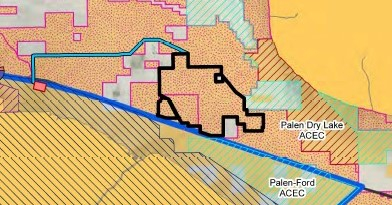
^Map of the Palen Solar Project in Riverside County CA.
EDF Renewable Energy has applied for a Right-of-Way (ROW) from the BLM to construct a 500 megawatt (MW) solar photovoltaic facility and 6.7-mile single circuit 230 kilovolt generation interconnection (gen-tie) transmission line on public lands near Desert Center, Riverside County, California.
The project site has a long history of attempts to develop large scale solar energy in its boundaries. It started out in 2009 as a concentrated solar thermal parabolic trough project and later in 2013 as two solar power towers. In both cases, the developers withdrew their proposals.
The project would destroy a large tract of desert sand dune habitat in the California Desert. The habitat is home to many sand dwelling species of plants and animals. The area has cultural significance to Native American Tribes. The project would have significant visual impacts to the landscape and will be visible from many adjacent conservation areas.
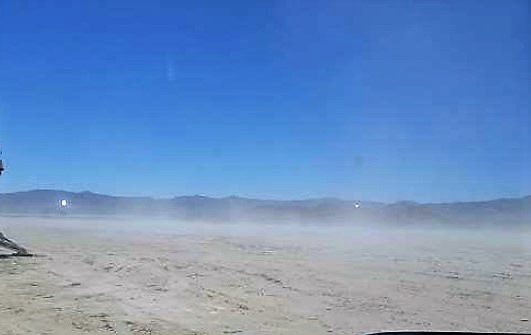
^Dust and desertification from the construction of the Stateline Solar Project, San Bernardino, California (photo, BLM 2014).
The BLM is deciding on the proposed plan and 3 alternatives. The Proposed Action would develop a 500 MW solar facility of 4,200 acres of BLM land. The Reduced Footprint Alternative would develop a 500 MW project on 3,100 acres of land. It would avoid a major wash and this is the BLM's preferred alternative. The Avoidance Alternative would develop up to 250 MW on 1,600 acres of land. This alternative follows the conservation recommendations of the Desert Renewable Energy Conservation Plan and avoids much of the sand transport corridor, but would still develop and impact a major portion of this habitat.
Basin and Range Watch supports the No Action/No Project Alternative! The environmental impacts of the Palen Solar Project can all be avoided by simply utilizing the benefits and endless Distributed Generation/Rooftop Solar opportunities in California.
Sample comment letter:
Bureau of Land Management
C/O Aspen Environmental Group
235 Montgomery Street
San Francisco, California 94104
email: palensolar@blm.gov
Fax: 760-833-7199 or you can comment from this link.
To Whom it May Concern,
Please choose the No Action/No Project Alternative for the following reasons:
The Palen Solar Project would create big visual impacts for the region. A solar project of any size will be visible from two wilderness areas and Joshua Tree National Park. A No Action Alternative would preserve part of the visual landscape in the region.
The Palen Solar Project will destroy Native American artifacts and cultural landscapes. This can not be mitigated.
The Palen Solar Project will impact many native desert species and damage an important and unique sand dune habitat. All 3 development alternatives will remove habitat for Mojave fringe-toed lizard, Harwood's milkvetch, desert tortoise, kit fox and desert microphyll woodlands. Sand dune habitats are unique and should not be sacrificed.
The Palen Solar Project will produce a "lake effect" which could attract birds and cause death or injury through collision and dehydration. Other recently built solar projects in the region have detected large bird mortality numbers and these include Threatened and Endangered species. Adding an additional 2 to 6 square miles of solar panels will cumulatively add to this problem.
The Palen Solar Project will create fugitive dust. The removal of established vegetation, biological soil crusts and centuries old desert pavement creates opportunities for dust to be airborne every time the wind blows. Not only does fugitive dust create problems for visual and biological resources, it creates issues for public health as well. Coccidioidomycosis (Valley Fever) has been a problem in the region.
The Palen Solar Project will contribute to California's problem of over-generating large-scale solar energy during peak times. It will also create a need for more unsightly and expensive transmission lines. All of the environmental impacts associated with the Palen Solar Project are not necessary because non-transmission alternatives can solve this problem. Distributed battery storage paired with rooftop solar systems would alleviate this issue. We can meet renewable energy needs in more environmentally friendly ways.
While the Palen Solar Project lies in a Development Focus Area established under the Desert Renewable Energy Conservation Plan (DRECP), it also predates the establishment of the DRECP and the BLM is not committed to following the Development Focus Area recommendations in the DRECP. In this case, any development in the location would create significant environmental impacts for the region.
Thank you
(Your name and info here)
Reasons to Support the No Action Alternative:
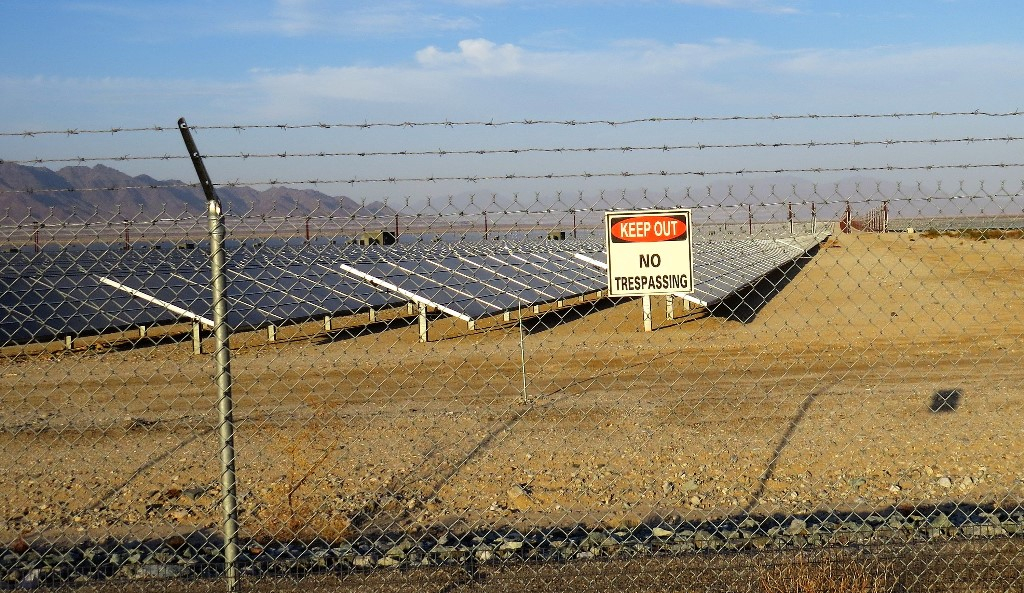
^Desert Sunlight Solar Project: The living desert on these public lands has been transformed to a single use solar project.
The Project Would Have Big Visual Impacts
The BLM has designated the region as the lowest possible Visual Resource Management classification. VRM Class IV - with the objective "to provide for management activities, which require major modification of the existing character of the landscape." But the project site is highly visible from the Palen-McCoy Wilderness Area, the Chuckwalla Wilderness Area and the Palen Dunes Area of Critical Environmental Concern which are all managed as VRM Class I and II. These classes have objectives of "preserving the existing character of the landscape" and "retaining the existing character of the landscape".
The project would also be visible from the southeast portion of Joshua Tree National Park.
The Project Would Impact Cultural Resources
Colorado River Indian Tribes have long opposed the construction of large solar projects located in the region. Many projects have resulted in cultural artifacts and human remains being removed by construction activity. The landscapes themselves are sacred to the tribes and the industrial construction of existing projects have damaged several thousand acres.
In 2012, several artifacts were dug up and destroyed during the construction of the Genesis Solar Project located along the Ford Dry Lake just east of the proposed Palen Solar Project.
The Project Would Impact Native Plants, Animals and important Sand Dune Habitat
The project is located on a sand sheet in the Colorado Desert sub-region of the Sonoran Desert. It is home to several species, many specialized to sandy habitats.
Several specialized species are found on the dune habitat including the Harwood's milkvetch and the Mojave fringe-toed lizard.
The Mojave fringe-toed lizard (Uma scoparia) is adapted to fine-grained sand dune environments. It has specialized "fringes" on its toes that allow it to "swim" in sand. The species is found throughout the project site. Fringe-toed lizards often will be seen outside of their core habitat in this region crossing from one dune to another. The project would kill lizards and remove habitat.
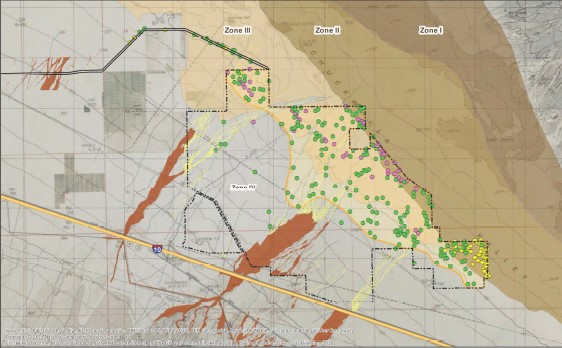
^This map shows where BLM surveys have found Mojave fringe-toed lizards. They are found on most of the project site. The project purports to "avoid" the sand transport system, but there is still plenty of sand habitat for Mojave fringe-toed lizards on all alternative footprints. Therefore the No Action Alternative is the best choice.
Desert Kit Foxes suffered an outbreak of canine distemper during the construction of the nearby Genesis Solar Project in 2011. The Palen Solar Project could remove over 6 square miles of habitat for foxes.
Lake Effect/Avian Mortality
Several bird mortalities have been detected at many of the large-scale solar facilities that have been built in the last decade. Large-scale solar projects often resemble lakes and this is believed to be a cause of some of the bird mortality that is being detected on projects like the Desert Sunlight Project which is just under 20 miles west of the proposed Palen Solar Project. The hypothesis is that birds are attracted to the polarized light of the panels, but other factors like color may confuse birds into perceiving the panels as water. It is believed that other resources like insect prey and artificial ponds also attract birds. From 2012 to 2016, 3,545 mortalities from 183 species were detected on California solar facilities. Some of these mortalities have been listed species including the the Federally Endangered Yuma clapper rail and Federally Threatened Western yellow-billed cuckoo. Waterbirds such as White pelican and Western grebe have been found dead at solar projects. These projects are very large and only a small percentage of certain projects are surveyed so it is likely that many mortalities are missed because they are taken by scavengers.
The proposed Palen Solar Power Project would be located between the Desert Sunlight Solar Project to the west and the Genesis Solar Project to the east. All three construction alternatives of the Palen Solar Power Project would add significant cumulative additional impacts to the bird mortality of the region. More information on avian solar mortality can be found here.
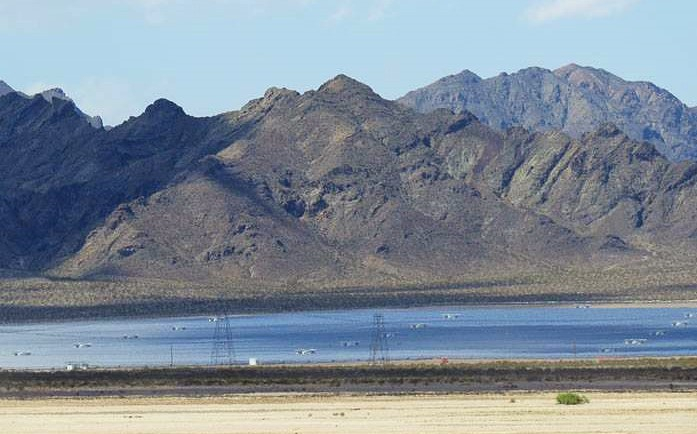
^Copper Mountain Solar Facility near Boulder City, Nevada. Millions of solar panels appear like a lake.
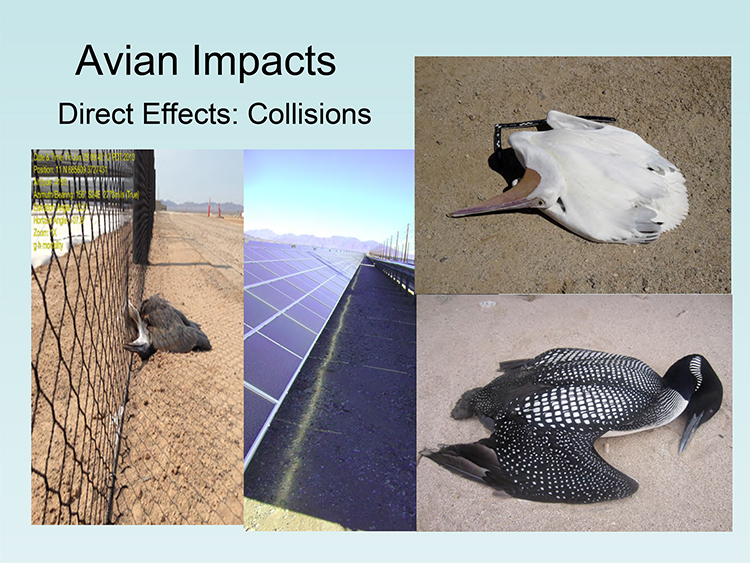
^Solar Bird Mortality - US Fish and Wildlife Service.
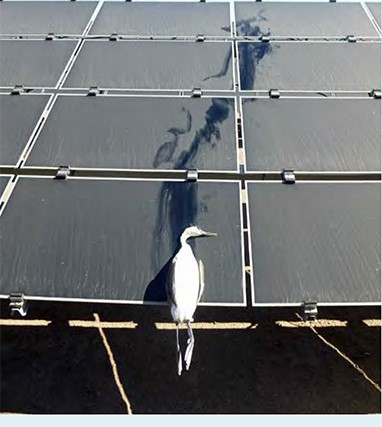
^ Grebe killed on Desert Sunlight Project.
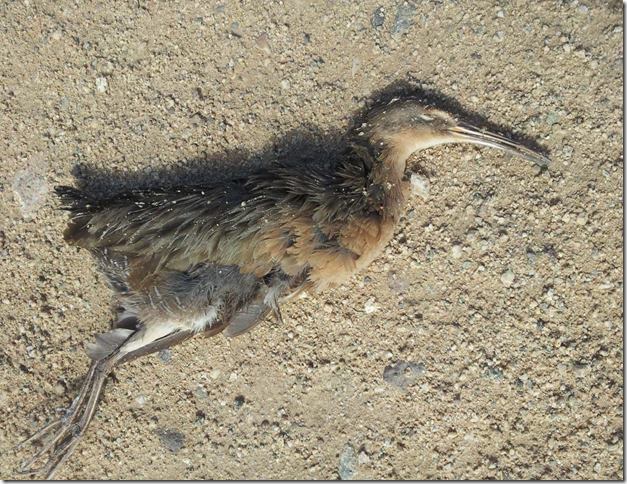
^Endangered Yuma clapper rail killed at Desert Sunlight Solar Project in 2012. Photo by US Fish and Wildlife Service.
Fugitive Dust From Clearing
Large-scale solar projects in the hot desert cause air quality problems. Dust control in hot, arid climates is very problematic. The removal of established vegetation, biological soil crusts and centuries old desert pavement creates opportunities for dust to be airborne every time the wind blows. Not only does fugitive dust create problems for visual and biological resources, it creates issues for public health as well. Efforts to mitigate fugitive dust on large desert regions often fall short.
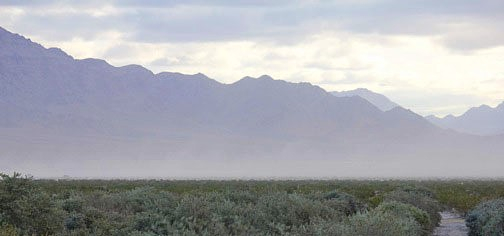
^Fugitive Dust from the Desert Sunlight Solar Project, 2010.
Coccidioidomycosis (Valley Fever) is a common issue that impacts desert communities when dust is stirred up. Valley fever has been spread by large-scale solar development in desert regions.
The Distributed Generation Solution
The California Independent System Operator (CaISO), California Energy Commission (CEC), and California Public Utilities Commission (CPUC) during Renewable Energy Transmission Initiative (RETI 2.0) meetings explain that California now has so much utility-scale solar that the state is over-generating in peak times.
Non-transmission alternatives can solve this problem: distributed battery storage paired with rooftop solar systems could offer peak load shaving. Net metering generators could be paid for the amount of solar energy they store, instead of selling excess back to the grid. Dispatchable technologies could be investigated in this distributed approach, instead of spending billions of dollars on new thousand-mile-long transmission lines. There are new models worth investigating to avoid giant land use costs of utility-scale solar and wind projects. And of course energy conservation and efficiency can help ease peak over-generation. Parking lot structures in California could produce 39,000 MW of solar energy.
Palen Solar Photovoltaic Project Back
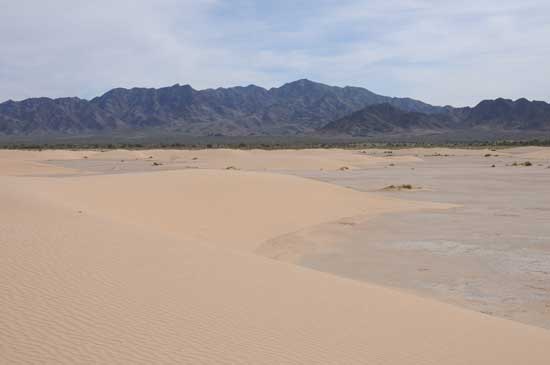
^The Palen Dunes sand transport corridor which may be threatened by a large fenced 3,500-acre utility-scale solar project. The Palen-McCoy Mountains and wilderness are in the distance.
October 26, 2017 - Riverside County CA - The Bureau of Land Management (BLM) is set to release a Draft Supplemental Environmental Impact Statement with a 45 day comment period, for a proposed 500 megawatt photovoltaic solar power plant near Desert Center, Riverside County, California. The Right-of-Way application area comprises about 4,200 acres, with a proposed project footprint of about 3,400 acres. The proposed project also includes construction of a 6.7-mile single circuit 230 kilovolt generation interconnection (gen-tie) transmission line connecting the project to the Southern California Edison (SCE) Red Bluff Substation. EDF Renewables is seeking to build the project. See the Federal Register notice pdf.
The project site is partially within a sand-transport corridor, and past incarnations of the project have been controversial because of this. The area also has a good population of Mojave fringe-toed lizards.
BLM and Riverside County will hold a public meeting on the Project DSEIS/SEIR/LUPA on November 14, 2017 from 4 to 6 pm at UCR Palm Desert Center Room B200 located at 75080 Frank Sinatra Drive, Palm Desert, CA 92211.
Comment deadline December 10, 2017.
New Palen Solar PV Project Reactivated With Little Public Notice
June 21, 2016 - Palm Springs CA - The Bureau of Land Management (BLM) is proposing a Supplemental Environmental Impact Statement for the re-awakened 500-megawatt Palen Solar Photovoltaic Project (formerly a concentrated solar thermal project, see below) for 4,200 acres of undisturbed desert ecosystem west of Desert Center in the Chuckwalla Valley of Riverside County CA. See the BLM notice mailed to a few parties.
Basin & Range Watch has long been an intervenor in the former California Energy Commission proceedings (CEC), although the CEC does not review photovoltaic solar projects, only those that have a thermal energy component. In 2015 the project switched owners and the CEC had made a decision on jurisdictional matters to continue reviewing the case once the applicant changed the technology, but then denied a request to extend deadlines of the project in the matter of amended reviews. This means the CEC opted out of any further review, leaving the BLM as sole permitting agency along with Riverside County.
A scoping meeting will be held June 29, 2016 from 3:30 PM to 5:30 PM at the Palm Springs City Hall, Palm Springs CA 92262.
Comments will be collected until July 18, 2016.
This is a very short notice for a single public meeting for so important a project in the California Desert. We were only made aware of it by our extensive network of desert advocates, not by receiving a BLM notice. BLM should place this notice on their website. Public meetings should also be held in Blythe CA.
EDF Renewables is proposing single-axis tracking photovoltaic panels, but does not have a Power Purchase Agreement with a utility yet for the project that we are aware of.
Raised From the Dead: Palen Solar Project Back
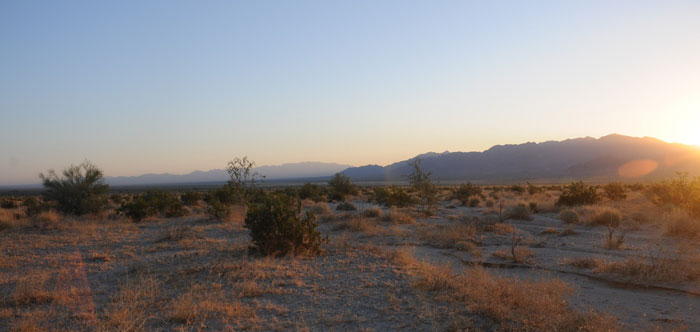
^Project site at sunset.
June 10, 2016 - Riverside County CA - The Palen Solar Power Project returns from the dead (again)! The Bureau of Land Management will process the application this summer. Since 2010, the Palen solar project has been proposed for the Chuckwalla Valley, Riverside County, west of Blythe, California. It started as a Concentrated Solar Thermal Plant parabolic trough design. The company, Solar Trust of America, went bankrupt and the application was sold to BrightSource and Abengoa. They planned on building two 750 foot power towers and later reduced the plan to just one tower. Both BrightSource and Abengoa ended up having their own financial issues and the project lacked a competent thermal storage plan. The project was later sold to EDF Renewables and converted to photovoltaic solar panels.
The California Energy Commission denied the application from EDF Renewables so now the project is being reviewed by BLM only.
It will still have big impacts on desert dune ecosystems as a whole, Mojave fringe-toed lizards, cultural resources and birds will most likely be killed hitting the panels. The BLM gave a presentation about the project at the Desert Advisory Council meeting in May.
From the BLM California Desert District Advisory Council Meeting: Palen Solar Power Project: EDF Renewable Energy submitted an application and Plan of Development, dated December 22, 2015, for a 500 MW photovoltaic solar generating facility. The project would be constructed entirely on BLM lands within the original project footprint and consist of a single solar field with two smaller adjacent solar fields, a main access road from the Corn Springs off-ramp, and a 230kV generation tie-line extending from the project switchyard to the Red Bluff Substation. The BLM is beginning processing of this application.
California Energy Commission Votes Against Granting Extension for Project
February 11, 2016 - In a surprise 5-0 vote the California Energy Commission denied an extension to the new owners of the Palen Solar Power Project, at a business meeting on the 10th. Commissioners heard comments by Andrew Bell, attorney for EDF Renewables (parent company to Maverick Solar LLC which recently acquired the Palen solar project). The Commissioners ruled on Petitions for Extension of Deadline for Commencement of Construction, and transfer of ownership of the project.
Past Intervenors were present and made comments to oppose transfer and extension of the deadline to begin construction: Center for Biological Diversity made very good arguments. Colorado River Indian Tribes and Basin & Range Watch also made comments.
Missed Deadlines
The petitioner EDF had missed the deadline for filing transfer of Palen Solar Electric Generating System I from Abengoa after that company's insolvency troubles, as well as missing the deadline for an extension of beginning of construction, but the attorney for EDF said the filing was "one minute thirty-four seconds late" due to website-uploading glitches. Commissioner Karen Douglas reminded EDF they could have come a week earlier to ask for an extension if the company needed time.
There is a five-year construction deadline statute where permits become void, and the Palen Solar Power Project has passed the five-year mark.
EDF pleaded that they had in fact filed their requests in a timely manner, or if a few minutes late, had done due diligence in their internal discussions on how to best move forward with this concentrated solar power project. They now sought to turn the project into a photovoltaic facility. They further requested a three month time frame to prepare an amendment to the original Staff Assessment.
County Concerns
The County of Riverside made a comment to the Commissioners, saying how they opposed the request for an extension of the project and allowing it to switch to photovoltaic technology. The county is mapping their lands for solar siting (from a grant given by the CEC), and they want local jurisdiction under the California Environmental Quality Act (CEQA).
Jurisdiction Over Photovoltaic Projects
Attorney Lisa Belenky of Center for Biological Diversity made excellent comments about a new CEC regulation that may revisit the jurisdiction question at a later date, on whether the CEC should license photovoltaic projects. Belenky asked that this important question be held in a fully public manner with hearings and comment periods. The Commissioners later assured those present that they would make this a public process if the question was to be discussed.
The statute that governs the California Energy Commission (the Warren-Alquist Act) explicitly only gives the CEC the ability to license thermal power plants, and not photovoltaic plants. In 2011 there was special legislation (SB 226, amending PRC 25500.1) that allowed CEC to oversee conversion of certain Fast-track solar projects from thermal to photovoltaic — the Calico and Blythe solar projects were part of that but Palen was expressly not allowed to use that legislation because it never had a Record of Decision (ROD) for an approval from the Bureau of Land Management. The Center argued that since Palen was not a Fast-track project and never got BLM approval, it is a dead project.
"Don't kick the can down the road while deciding about jurisdiction," Belenky said to the Commissioners.
New Environmental Review Needed
Ms. Belenky also commented that the environmental review should be re-started from the beginning, that most surveys and analysis were undertaken years ago, and more recent analysis was only piecemeal. Essential new information, as well as the Desert Renewable Energy Conservation Plan (DRECP), has come to the fore and has not been analyzed.
EDF argued that their new PV project would have no new significant impacts, a point we disagree with.
Commissioners' Decision
After going into a closed session for deliberation for about 15 minutes, the Commissioners returned with a unanimous vote denying the petitioner's request for an extension of the project's commencement of construction. This essentially denied the project developer any opportunity for a review and license with the CEC.
Commissioner Douglas told EDF they should go forward with their project with the appropriate permitting agencies (the county and BLM). She pointed out that the CEC record was over five years old and involved issues such as solar flux from a power tower, different from photovoltaic technology. Much of the record would need to be updated. She said the developer could go back and gather more information about their project, and in the future come back to the CEC and ask about the jurisdictional issue.
EDF was between a rock and a hard place on this one--the California Public Utilities Commission now prefers new solar projects to be concentrated solar thermal with storage to help balance out the grid, but everyone knows how expensive those are so EDF wanted to do cheaper photovoltaic.
Is Palen Dead?
We never say never. Perhaps EDF will regroup and go the county and restart their review, but they were hoping to piggyback on the extensive record and environmental review already built up during the CEC proceeding.
New Palen Owner Seeks 6 Month Extension and Switch to Photovolatic
December 23, 2015 - Maverick Solar has petitoned the California Energy Commission (CEC) for an extension of the deadline for commencement of construction by 12 months, following another extension to June 2016 for the developer to submit a petiton to amend the project. Also the developer is seeking to switch to photovoltaic technology, from solar trough CSP technology.
See the CEC petition >>here.
Change of Ownership of Project
December 16, 2015 - On December 15 Palen SEGS I LLC petitoned the California Energy Commission for a transfer of ownership of the Palen Solar Power Project to Maverick Solar LLC out of San Diego, a subsidiary of EDF Renewable Energy (formerly enXco). EDF Renewable Energy is the US subsidiary of EDF Energies Nouvelles, an arm of the large European utility EDF group. The company develops photovoltaic solar and wind projects. The Palen project will likely move to a PV technology, from CSP.
The company also requested a 12 month extension of the start of construction date.
Abengoa Starts Insolvency Proceedings
November 27, 2015 - The Spanish solar company's shares dropped as it announced insolvency proceedings; it has four months to reach a deal with creditors or potenitally face bankruptcy. This brings into question whether the company has the ability to continue to develop the Palen Solar Power Project which it recently took over from BrightSource Energy. Abengoa needs to have its new plan of development to the California Energy Commission by December 22, 2015.
http://uk.reuters.com/article/2015/11/25/abengoa-gonvarri-idUKL8N13K16B20151125
Palen Proposed to be "Peaker" Plant With Storage
September 9, 2015 - The California Energy Commission held a public hearing today to consider whether to grant Abengoa's request for an extension and to file a petition to amend the original application. Environmental groups and tribal representatives had requested a whole new application be required of the company since the design has changed again and years have gone by since the original Solar Millennium application was filed.
Center for Biological Diversity said there is significant new information, such as about surface hydrology. Impacts to the other large solar projects in the area (Genesis and Desert Sunlight) from flooding has led to much new information about how these projects impact desert landscapes, and this has never been evaluated. There would be new impacts to the Mojave fringe-toed lizard as the rarity of its habitat has become more apparent. New impacts to cultural resources have also been found since the original application.
Basin & Range Watch made comments that the project would up its water use with thermal storage, and pointed out that the applicant a few years ago said a solar trough project was not feasible on this site. Now they say it is.
At the end of the hearing, however, the Commissioners granted the extension and request of Abengoa to file a petition to supplement the original application. It must be done before December 22, 2016 when the permit expires.
Abengoa explained it would change the solar trough design to use new updated technology and more efficient troughs, resulting in a smaller footprint of land that would need to be graded. Molten salt tanks would be added by the power block but Abengoa intended this project to be a "peaker" plant that would be a minor reconfiguration, providing a capacity product to the market that is flexible during peak hours like a peaker natural gas plant. Therefore the solar field could be smaller since so much extra energy would not be stored (into the night hours).
Abengoa Switches From Power Tower to Solar Trough Technology
August 27, 2015 - Attorneys for Abengoa sent in this letter to the California Energy Commission (CEC) to announce they were changing their design of the Palen Solar Power Project from power tower to solar trough technology, which would have molten salt storage. This may complicate the review, as other trough plants using thermal salt storage need wet cooling instead of dry cooling technology. The Solana project in Arizona requires 3,000 acre-feet per year of groundwater for their wet-cooling towers. The Mojave solar trough project at Harper Lake CA uses 2,000 acre feet a year. This is a large amount in drought-striken California, and is considerably more than the BrightSource solar power tower asked for with dry cooling technology.
Since it is has been five years after the original application, Abengoa must go back to the drawing board according to CEC policy. The CEC has permitted a solar trough design at the site already -- the former Solar Millennium project. The Bureau of Land Management never finalized that environmental impact statement, however. The project is in a Solar Energy Zone designated under the Solar Programmatic Environmental Impact Statement review.
And You Thought Palen Was Dead
November 4, 2014 - Chuckwalla Valley, Riverside County CA - The Palen solar project, formerly 750-foot-tall solar power towers proposed by BrightSource Energy and the Spanish company Abengoa, is back. The project would forego natural gas apparently and instead build molten salt storage.
According to Abengoa's website: Abengoa, an international company that applies innovative technology solutions for sustainability in the energy and environmental sectors, has agreed to a deal with BrightSource Energy under which Abengoa will acquire BrightSource Energy's interest in the Palen Solar Energy Generating Station (PSEGS) project. Upon finalization of the purchase transaction, Abengoa will become the sole developer of the project. The Project will continue to use tower technology, but Abengoa intends to propose its molten salt tower proprietary technology, incorporating large thermal energy storage capacity. Details of the transaction have not been disclosed.
Palen Solar Power Tower Project Withdrawn
September 29, 2014 - Unexpectedly, BrightSource Energy and Abengoa Solar withdrew their Palen Solar Electric Generating System project in a brief letter to the California Energy Commission on September 26. No reason was given. The project had been plagued by issues ranging from high potential bird mortality from solar flux, which is unfolding at the Ivanpah solar project, to cultural concerns by local tribes.
Other looming problems involved the Energy Commission's recommendation to integrate thermal storage into the solar power tower design, something which the developers admitted would take time to engineer. The first out of two power tower was on the verge of approval by the full five member Commission, after a yes recommendation by the two Presiding Members of the Commission recently. The second tower would need to have thermal storage to come before a review in the future.
The Desert Sun reported that BrightSource senior vice president Joe Desmond explained that the companies chose to withdraw the application in part because the project was unlikely to be completed by December 2016, meaning it wouldn’t qualify for a 30 percent investment tax credit that expires at the end of that year.
Energy Commission Recommends License for First Tower
September 12. 2014 - The two commissioners of the California Energy Commission (CEC) presiding over the hearing and review of the Palen Solar Electric Generating System (PSEGS) have written their Revised Presiding Member's Proposed Decision which recommends phase 1 be licensed, one solar power tower. Then a second power tower with thermal energy storage may be built in the future if the petitioner BrightSource Energy seeks to amend yet again. The decision will be passed on to a vote of the whole five commissioners for final approval.
The decision recommends a reduced acreage alternative, which the Energy Commission says will reduce and outweigh significant impacts, but still must override the worst impacts as unmitigable: cultural impacts, some biological concerns, and visual resources.
The Reduced Acreage Alternative would further reduce the project footprint to approximately 1,960 acres.
But the CEC writes, "In light of the foreseeable future Application for Certification on the second phase of PSEGS, we have decided to leave intact the analysis of both phases of the PSEGS project. We believe it is beneficial to the public and potential future applicants to be apprised of the environmental impacts and mitigation analysis of both phases of the PSEGS project, even though we are only certifying the Reduced Acreage Alternative." This will make it easy for BrightSource to come back in the future to petition to amend the project again for a phase 2 power tower with thermal energy storage when this becomes feasible.
Not wholly able to generate electricity from the Sun, the plant would also burn natural gas. The unit would contain two natural-gas-fired boilers to assist with daily startup of the power generation equipment and to preserve energy in the steam cycle overnight. The unit would contain the following boiler equipment:
• One 249-MMBtu/hr (Million Metric British thermal units per hour) packaged natural- gas-fired auxiliary boiler for startup and cycle augmentation, capable of producing 185,000 pounds per hour (lb/hr) at 770°F and 650 psia; and
• One 10-MMBtu/hr natural-gas-fired “night preservation” boiler to maintain system temperatures overnight, capable of producing 10,000 lb/hr at 500°F and 175 psia.
The PSEGS would use natural gas to fire its auxiliary and nighttime preservation boilers. SoCal Gas would supply natural gas for PSEGS via a new pipeline that would extend southward from the site and interconnect with an existing SoCal Gas transmission pipeline located just south of I-10. The new gas pipeline approximately eight inches in diameter and 2,956 feet long.
In addition to an air-cooled condenser to cool the system, a wet-cooled system would also be used. This evaporates groundwater significantly more.
The solar plant would use 201 acre-feet per year of water for process use, mirror washing, dust suppression, and potable water. That amounts to 179,078 gallons per day.
Bird Mortality and Solar Flux
Bird and insect deaths will occur: according to the decision: "The PSEGS project will introduce several factors that could result in mortality, morbidity, and reduced reproductive success in birds, bats, and insects. Potential impacts of the operating facility to birds, bats, and insects include physical injury resulting from collision with power towers, heliostats, or other project infrastructure features, electrocution, and disorientation (disturbance from lighting, mirror reflection, etc.). Ocular damage, hyperthermia and, depending on period of exposure and level of flux, burning and other heat-caused damage to internal and external body parts, as well as residual damage (morbidity) may occur to bats, birds, or insects that enter the airspace over the heliostat field where elevated solar flux exists."
The solar flux will have impacts: "Operation of the PSEGS would concentrate the sun’s radiant energy (flux or solar flux) over the heliostat field. Flux levels increase approaching the power towers and occupy the airspace over the heliostat fields. Any species of bird, bat, or insect that enters this airspace and is exposed to concentrated solar flux is at risk of injury, latent mortality on or off the project site, and mortality within the project footprint. The type and severity of damage experienced is not predictable; however, it is directly linked to the duration of exposure and the intensity of the flux encountered. While safe limits of flux have been established for humans and the adverse effects of exposure well documented, little information exists to help understand what levels of flux may be safe for bats, birds, and insects."
The Energy Commission staff "recommends that additional data should be collected from ISEGS before approving the PSEGS facility at this time. The data should be scaled up to account for the size of the facility and corrected for important factors such as searcher efficiency and scavenger removal rates. The data should be corrected to adjust for birds that are injured yet are able to fly off the site and avoid detection. Staff argues that none of the mortality data provides any potential for mass mortality events if flocks of birds fly through the flux field. Staff considers this a predictable event based on the large flocks of birds detected at PSEGS during autumn 2013 surveys, and that many of these species have flight characteristics or behaviors that would expose the birds to elevated levels of solar flux."
And about the numbers -- "Staff calculated that the PSEGS flux field would occupy 3.8 times the volume of the ISEGS flux field on a per-tower basis. Staff found that avian mortality increased nearer to the tower. Finally, Staff found that the 250-megawatt solar tower at 240 meters high, as is proposed for PSEGS, would present a risk that is 3.7 times higher per tower than that presented by a 125-megawatt ISEGS solar tower at 120 meters g. (7/30/14 RT 276:5 – 277:14.) Nevertheless, Staff did not offer any estimate for avian mortality due to solar flux."
BrightSource may write a check and get away with uncontrolled bird slaughter:
"Staff did not recommend adoption of the project owner’s offer of 1:1 habitat offsets for avian and bat species. While acquisitions are valuable and ensure long-term preservation of habitat, Staff believes that the requirements of BIO-12 are equally conservative, ensuring acquisition of high quality habitat for the Desert Tortoise that would also benefit avian species. Additionally, the stated selection requirements would likely “nest” or overlap with the Desert Tortoise offsets and, therefore, would not ultimately result in acquisitions further than already recommended within BIO-12. Habitat acquisition is a useful tool. However, when attempting to mitigate potential ongoing losses of such a mobile and diverse group of vertebrates such as migratory birds, in particular, and insects and bats to a lesser degree, restoration and enhancement of habitat may prove more useful than placing conservation easements. Restoration of habitat is one of few means of “creating” new habitat and has the possibility of expanding both abundance and, in some instances, the range, of birds, bats, and insects. (Ex. 2000, p. 4.2-165.)
"The Petitioner offered $500,000 towards funding various habitat enhancement and conservation actions, and Staff has also recommended this. However, rather than payment of a lump sum, Staff recommend that the project owner fund an interest- bearing account to achieve this same goal. Monies held in an interest-bearing account would be managed by a non profit investment entity (e.g., a community foundation such as the Imperial Valley Community Foundation) from which only annually earned interest and fund management fees may be distributed; that is, the investment vehicle would be designed and managed as an interest-bearing account. (Ex. 2000, p. 4.2-165.)
"Staff testified that a minimum annual benefit of approximately $50,000 would be necessary to fund bird mitigation actions during the operational life of the project. Staff testified that in order to yield approximately $50,000 annually, the project owner would need to provide approximately $1,500,000 into an interest-bearing account. The recommended funding amount was determined by considering three primary factors:
"1. A reasonable/achievable rate of capitalization (4.0%per annum);
2. Adequacy of the amount of the investment to allow for portfolio diversification;
3. An annual funding amount of significant benefit to the affected resource (Ex. 2000, p. 4.2-166).
"The actual funds needed to support this program may vary. While this approach is more costly than originally proposed by the Petitioner, Staff believes the approach is reasonable and may provide indirect benefits to the project owner, primarily that funds would be available to the project owner at the end of the project, annual payouts would not incur tax liabilities, the program would provide not only annual revenue for an extended period but does so in a fiscally responsible manner, and the level of funding is expected to provide a significant, demonstrable, and measurable mitigation value that is linked directly, both spatially and temporally, to facility operation. (Ex. 2000, p. 4.2-166.)
"Alternatively, the project owner may pay $50,000 annually to fund the conservation activities for the life of the project. If the project owner elects to make annual payments, the annual payments would be adjusted for inflation. (Ex. 2000, p. 4.2-166.)"
Cultural Concerns
The Energy Commission unfortunately chose to ignore the strong concerns of the native tribes who value this land, and issued an override of significant impacts under the California Environmental Quality Act.
The decision reads in part: "The Reduced Acreage Alternative may also permanently change and/or result in the destruction of cultural resources both known, and as yet unknown, contributing to a cumulatively considerable impact that will be mitigated to the extent feasible, but may remain significant after such mitigation....The PSEGS project’s direct and cumulative impacts to cultural resources are borne disproportionately by Native Americans. "
Birds Igniting in Midair: CBS News Reports on Ivanpah and Palen Solar Power Towers
August 18, 2014 - CBS News headlines the controversy over bird deaths at the Ivanpah Solar Electric Generating System raised by biologists:
http://www.cbsnews.com/news/calif-solar-power-plants-scorching-birds-in-midair/
California Energy Commission Evidentiary Hearing
August 10, 2014 - Blythe CA - Basin & Range Watch intervened in the California Energy Commission (CEC) proceeding of this petition to amend the original Palen solar project application after BrightSource Energy bought the application from now bankrupt Solar Millennium. The current project would involve two solar power towers that would superheat water into steam to turn steam turbines in power blocks. Hundreds of thousands of mirrors (heliostats) in circles around the towers would aim sunlight onto the receiver of the tower to heat the water into steam.
The California Energy Commission held an evidentiary hearing in Blythe over two long days, July 29 and 30, 2014, where all intervenors, the petitioner BrightSource Energy, staff of the Energy Commission, and the public gathered. Intervenors include Basin & Range Watch, Center for Biological Diversity (CBD), Colorado River Indian Tribes (CRIT), and Californians for Renewable Energy (CARE) - La Cuna de Aztlan. More >>here.
BrightSource Working to Revive Project
February 4, 2014 - The California Energy Commission (CEC) on January 23, 2014, released a decision that the petitioner Palen Solar Holdings could work to gather new information in order to make the solar power tower project viable in the Commission's opinion. The petitioner had requested a delay in the final full commission decision on whether to end the application process, and the CEC granted this.
At a Committee conference, specific directions were given to gather data on reconfiguration and new mitigation measures. Palen Solar Holdings sent a letter to the CEC saying they were gathering this new information. BrightSource and the Spanish company Abengoa are the parent companies seeking to design and construct the solar project.
The following material will be submitted according to the petitioner:
• A comparison of avian mortality data reported by projects utilizing various solar technologies.
• A more detailed description of the benefits of the PSEGS, including the potential to incorporate thermal energy storage at the project in the future.
• A more detailed description of why the No Project Alternative and the Photovoltaic
Alternative are infeasible alternatives to the PSEGS.
• A proposed modification to a cultural mitigation measure that more appropriately provides mitigation directed towards tribal spiritual and cultural values while also providing mitigation for the State’s interest in recording historically important sites.
Palen Solar Electric Generating System: Denied
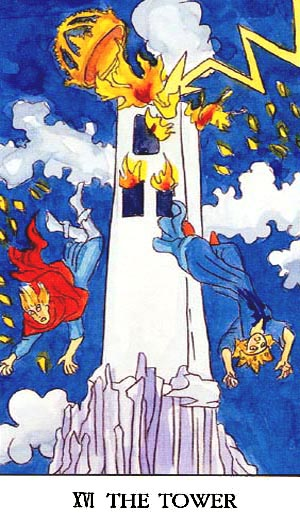
December 13, 2013 - During a business meeting in Sacramento today the California Energy Commission recommended that the application for the Palen solar power tower project by BrightSource Energy be denied.
From the Decision (http://docketpublic.energy.ca.gov/PublicDocuments/09-AFC-07C/TN201434_20131213T150623_Presiding_Member's_Proposed_Decision.pdf) page 972:
“We conclude, in the BIOLOGICAL RESOURCES section of this Decision, that currently there is insufficient scientifically deduced information about actual avian impacts from power tower solar flux. However, other evidence in the record about avian species mortality from solar flux, including preliminary compliance monitoring information from the Ivanpah project, convinces us that the benefits of the PSEGS modified project do not outweigh its significant adverse environmental effects. When we compare the PSEGS' entire suite of benefits against its suite of impacts, we find that the impacts outweigh the benefits. Accordingly, the Petition to Amend the Palen Solar Electricity Generating System is DENIED.”
National Park Service Comments on the Palen Solar Power Towers
November 18, 2013 - As Joshua Tree National Park lies within view of these proposed 750-foot solar thermal towers, the National Park Service gave comments on the project's impacts: >>download the 183 KB pdf.
California Energy Commission Evidentiary Hearing
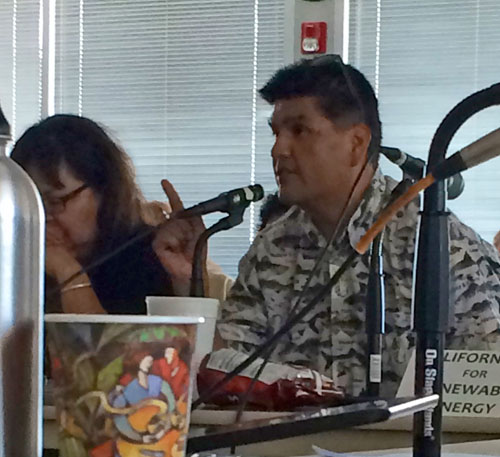
November 4, 2013 - Basin & Range Watch was an intervenor at the California Energy Commission (CEC) evidentiary hearing in Palm Desert on October 28 and 29, 2013. This is the last phase in the licensing review by the state agency as it carries out environmental review under the California Environmental Quality Act (CEQA) for a thermal power plant. The Bureau of Land Management (BLM) is undergoing a parallel review under the National Environmental Policy Act since the project is on federal land.
Other intervenors include Center for Biological Diversity (CBD), Colorado River Indian Tribes, and Californians for Renewable Energy.
The now defunct company Solar Millennium had originally proposed this project, using a solar trough technology to heat steam in a power block. BrightSource Energy later bought the project, and along with Abengoa, is currently seeking a license to build a solar power tower facility. Thus the current hearing addresses the changes to a project already approved by the CEC (but not yet by BLM). The project will cost close to $2 billion to construct.
The Quechan representatives and Colorado River Indian Tribes were outraged because this power plant has similar properties to the Genesis Solar Energy Project where a village site and cremation site were found. The tribes wanted no project and made eloquent speeches for hours about how important the area is to them and their history and traditions.
On alternatives, we had proposed Westlands Water District contaminated brownfields as a site to analyze to place this massive solar project, instead of living desert ecosystem. But the CEC's response was that it was "too far away" for the Energy Commission to consider. We asked them if there was a specific mileage distance that was in CEC policy that limited the distance considered for an alternative? Answer: No. Distributed generation such as rooftop solar was not discussed.
The visual landscape will be changed drastically in the area, with two 750-foot tall glowing power towers and hundreds of thousands of mirrors reflecting sunlight over five square miles. Everyone admitted these represent significant unmitigable impacts, so an override will probably be doled out (the CEC has given itself the power to override significant impacts in CEQA if deemed in the public interest). CEC had not addressed the impact to hikers, campers, and recreationists in the nearby wilderness areas and Joshua Tree National Park. CEC had a condition that there will be a 1-800 number for people to call in case they see an errant flash glare from a mirror or blinding light from the glowing receiver. Drivers on I-10 can call this number. We also brought up curtailment -- turn the heliostats up so they don't glint as much to people on the ground during certain times. Riverside County was on the phone and interjected that they wanted to make sure an expert on heliostat operation was on the phone.

^The solar power tower under testing at Ivanpah Valley, CA.
CEC said they admit birds will be killed by the solar flux at the power towers. Mitigation has yet to be determined. Adaptive Management was said to be the main way to deal with bird kills, as the problem will be deferred and studied. No one seemed to know what to do about this.
Center for Biological Diversity expert witness herpetologist Al Muth showed a fantastic photo of a 6-foot-high chainlink fence near Palm Springs covered to the top with a mound of sand. The proposed solar array will be partially in the path of a sand transport corridor at Palen, with chainlink fences around the heliostat field. They could get buried in a similar fashion. The topic of downwind sand habitat was highly contentious: how the fences will or will not stop the sand flow and degrade Mojave fringe-toed lizard habitat. Dr. Muth gave testimony that the sand on the downwind side of the project will deflate and stabilize eventually, and lose quality for sand-dwelling species as has happened in the Coachella Valley.
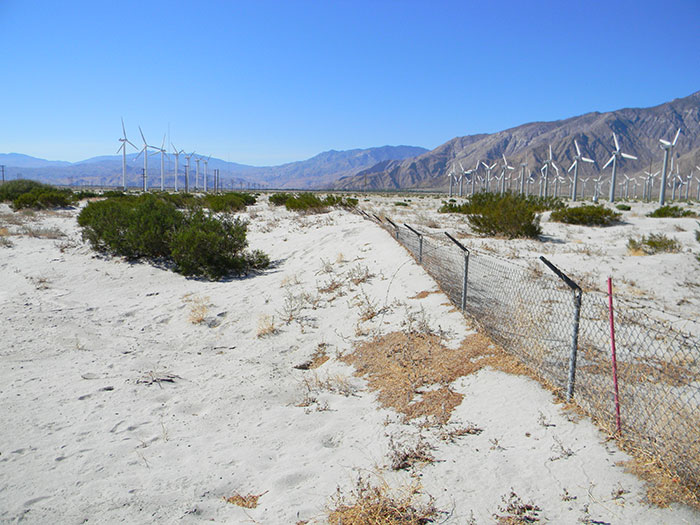
^Photo taken by Dr. Al Muth of a 6-foot high chainlink fence in the Palm Springs area covered by sand. BrightSource and Abengoa are proposing to surround their solar project by similar chainlink fences, partly in a sand transport corridor in Chuckwalla Valley.
Ileene Anderson of CBD argued well to have a system in place to pay for a kit fox monitoring plan to make sure another outbreak of canine distemper will not happen, as occurred at Genesis. She called a California Department of Fish and Wildlife representative up to testify how they will regulate this (no definitive answer).
CBD expert witness Pat Flanagan, who had worked as a biologist at the former Solar 1 power tower once in operation in Daggett, CA, gave testimony to the remarkable number of avian species in the area, brought up the issue of "land facets" (connectivity issues), and how she did not think the mitigation proposals so far would work. An adaptive management strategy was proposed by BrightSource and Abengoa of using such devices as plastic owls, trained dogs, and canons to dissuade birds from flying near the power tower.
Also see the article in the Desert Sun:
Bird Mitigation Proposed for Palen Solar Power Towers
October 25, 2013 - BrightSource Energy intends to scare the birds away from the solar flux around the operating power towers for the Palen Solar Electric Generating System in several possible ways. Some measures proposed include driving ATVs around, firing shot guns and cannons, dogs will be trained to scare birds away, as well as possibly trained falcons.
http://docketpublic.energy.ca.gov/PublicDocuments/09-AFC-07C/TN200968_20131021T152056_PSH's_Rebuttal_Testimony_to_Intervenor_CBD's_Opening_Testimony.pdf
Summary of Potential Avian Adoptive Management Measures by Category:
--Facility habitat and prey control.
--Perch and nest-proofing.
--Netting or other enclosures.
--Dog, raptor other animal related deterrence. This could include trained falcons to chase birds away from the project.
--Actively managed radiocontrolled aircraft, water cannons, shotgun blasts, ATVs.
--Radar and long-range focused, bio-acoustics or visual deterrence. These could include strobe, revolving and amber barricade lights; reflective Mylar tape mounted as streamers or spans; stationary or mechanical pop-up scarecrows or effigies; black, white or other colored plastic flags; reflective Mylar balloons, including balloons marked with predator “eyespots” or that include suspended kites shaped like a hawk or an eagle; laser light emitted including hand-held units, kites, and kite-hawks and other mobile predator models; stationary predator models
BLM Meeting in Blythe
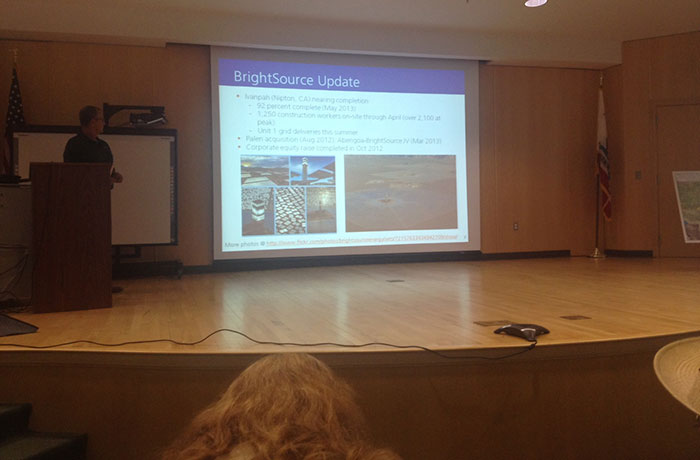
September 21, 2013 - Blythe, CA - The Bureau of Land Management (BLM) held a public meeting to hear comments on their environmental review of the Palen solar project on public land in Chuckwalla Valley, Riverside County CA. Members of Basin & Range Watch attended. BLM expects to issue their Record of Decision on the project around January 17, 2014.
BrightSource Energy and the Spanish company Abengoa are proposing to develop the project, and BrightSource gave a presentation. Abengoa would construct the project while BrightSource would be the technology provider. We note that these large-scale solar thermal power plants have proven difficult to build, and this is not the first time Spanish expertise has been brought in to provide engineering and construction services. Solar Reserve brought in Spanish experts to help overcome problems encountered during the construction of the Crescent Dunes power tower near Tonopah, NV.
The Palen solar project has power purchase agreements from Pacific Gas & Electric to provide power to the grid. BrightSource is hoping to push for a 2016 completion date in order to qualify for the federal Investment Tax Credit for solar. The project would cost $2 billion plus to build.

The Ivanpah solar project was described as "generation 1" power tower technology, while the Palen power towers will be "generation 2."
Joshua Tree National Park would be 8 miles away from the project, so views from park areas will be a concern.
Total water usage according to BrightSource's estimates would be 7,160 acre-feet, and of that 1,139 af would be used for construction. Operational use would be 231 acre-feet/year, mostly for washing the mirrors and regeneration in the steam process. Two evaporation ponds would be 4 acres each.
A half-mile long 8-inch natural gas pipeline would go to the project boilers from a mainline owned by Southern California Edison. Natural gas would be burned in daily start-up of the plant and during cloudy days.
A difference between the Palen project and Ivanpah facility are in how the heliostats are controlled as they move during the day tracking the sun to bounce sunlight onto the tower. At Ivanpah the heliostat mirrors are all connected by wires along the ground to feed them power to move and direct their position; at Palen the heliostats will be wirelessly controlled and powered by solar power.
Basin & Range Watch asked about the recent bird mortality at Ivanpah, including a peregrine falcon that was apparently blinded by the intense solar flux during power tower testing, as well as other bird deaths at solar plants. How will these be prevented or mitigated? BLM representatives said there was a private meeting being organized for next week with BLM, US Fish and Wildlife Service, and bird experts to try to address those issues.
Local and Native American Concerns
Representatives of the local group La Cuna de Aztlan Sacred Sites Protection Circle -- Alfredo Figueroa and Jesse Figueroa -- voiced their concerns about Native American sacred sites and culture in the region. Mr. Figueroa explained how the Palen project would be right in the middle of many sacred sites, in a wash from Corn Springs.
^Aztec Sickness (Save the Geoglyphs), singing by Jesse Alfredo, filmed by Robert Lundahl.
Quechan Historical Preservation Officer Arlene Kingery said the tribe opposed the Palen project, primarily on the grounds that the viewshed would be disrupted. The Quechan may request to try to locate burial sites on the project by using forensic dogs.
BLM said they will not officially take spoken comments on the record anymore, only written comments. This is controversial with people who drove hundreds of miles sometimes to reach the meeting.
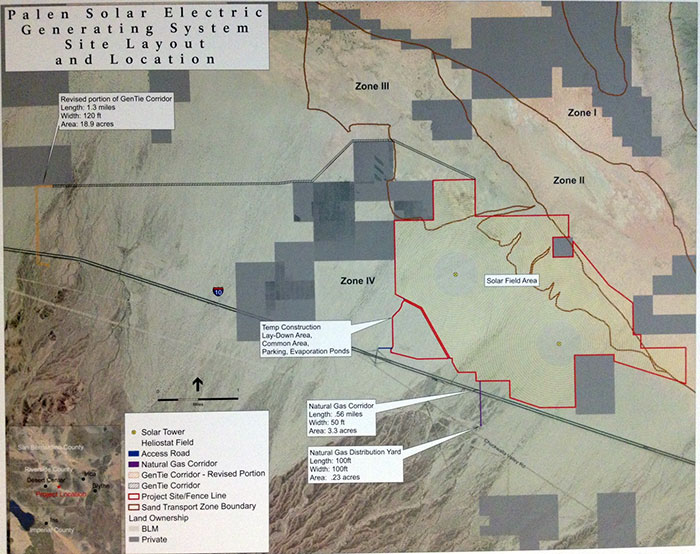
^The project site outlined in red in Chuckwalla Valley.
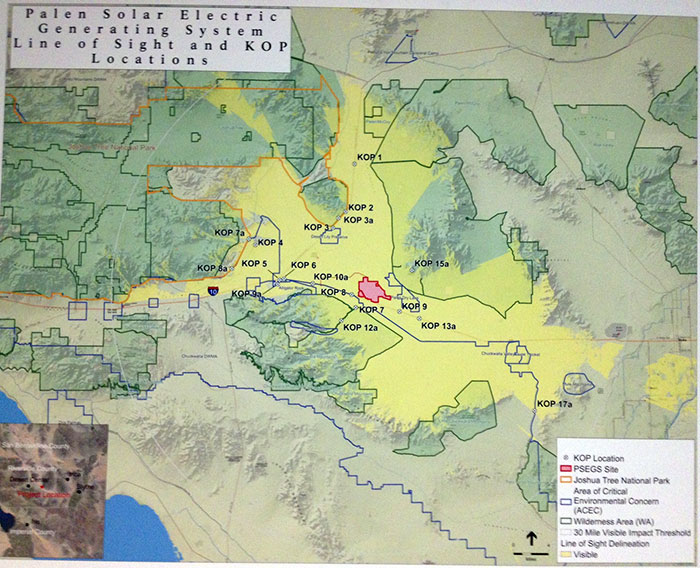
^Yellow shows where the project will be visible from, including Joshua Tree National Park.
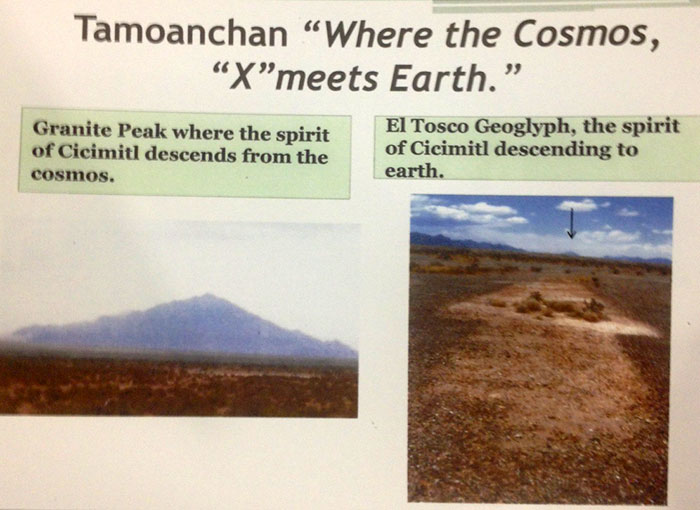
^Document explaining the meaning of sacred sites near Blythe, CA, by Alfredo Figueroa.
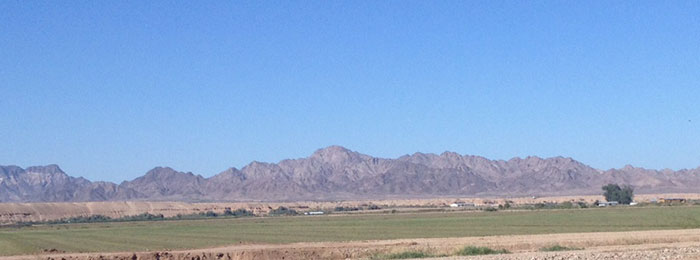
^The Big Maria Mountains and Palo Verde Mesa, showing the image of Tlaltecuhtli in the central domed mountain peak. There are dozens if not hundreds of such images that are read in the rocks like a book of history according to Alfredo Figueroa.
California Energy Commission Releases Final Staff Assessment
September 10, 2013 - The Palen Solar Electric Generating System Final Staff Assessment - Part A, at 1639 pages, was released as the environmental review process speeds ahead under the state agency.
Subjects covered include Alternatives, Biological Resources, Efficiency, Executive Summary, Facility Design, Compliance, Geology/Paleontology, Hazardous Materials, Introduction, Land Use, Noise and Vibration, Project Description, Public Health, Reliability, Socioeconomics, Traffic and Transportation, Transmission Line Safety and Nuisance, Transmission System Engineering, Visual Resources, Worker Safety and Fire Protection, Waste Management, and Soil and Water.
Go to the CEC Documents page and download the PDF file of the Final Staff Assessment: https://efiling.energy.ca.gov/Lists/DocketLog.aspx?docketnumber=09-AFC-07C
See also the excellent post on Mojave Desert Blog: http://www.mojavedesertblog.com/2013/09/brightsource-palen-solar-project-moving.html
Sand Transport Corridor an Issue Again
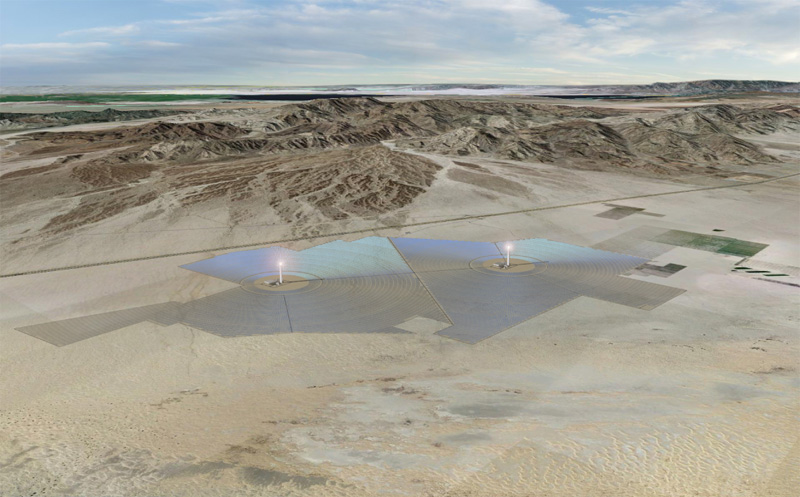
^Aerial view of a digital visualization of the proposed Palen Solar Electric Generating System with two power towers, looking southwest across the sand dunes of Chuckwalla Valley, across the I-10 highway, and the Salton Sea and Imperial Valley visible in the distance.
July 26, 2013 - During a two-day workshop held in Sacramento at the California Energy Commission (CEC) offices, BrightSource Energy discussed with various Energy Commission staff, biologists, agency reps, and intervenors how to crunch the numbers of mitigating impacts to resources at the Palen solar power tower project in Riverside County, CA.
85,000 heliostats would be built in each unit. One problem is that this particular design will block part of the sand transport corridor that moves west to east on blowing winds down the Chuckwalla Valley.
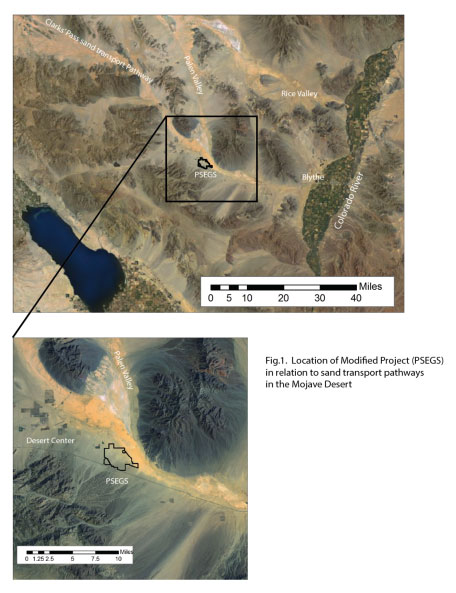
According to a study commissioned by the CEC and made available in July 2013, Geomorphic Assessment of Sand Transport for the Modified Project, by Nicholas Lancaster, Thomas Bullard and Jack Gillies the Desert Research Institute in Reno NV, "Modeling of the effects of the Modified Project on sand transport in the Palen Valley indicates that the Project has an increased level of predicted effects on sand transport, compared to the Applicant’s Reconfigured Alternatives 2 and 3. This is because the project footprint extends further east into the sand transport corridor.... The Modified
Project heliostat array is predicted to have a very significant effect on sand transport such that sand transport will be reduced by 93% at 1738 feet into the array."
Numerous Mojave fringe-toed lizards (Uma scoparia) were found in this sand transport corridor habitat, as these lizards prefer looser sand areas. Much habitat would therefore be destroyed by a project here, and indirect impacts would be large due to a modification of the moving sand habitat. A mitigation measure of land acquisition was proposed but the applicant will have difficulty finding enough private land to purchase, and instead a proposal to place money in a fund whereby Bureau of Land Management and California Department of Fish and Wildlife would try to restore habitat areas from off-roading and carry out weed removal.
The applicant proposed moving sand inside the fence of the project to re-supply the sand transport corridor. Other mitigation measures proposed were adaptive management and monitoring of the sand habitat being impacted. The applicant proposed surveying for fringe-toed lizards annually in the degraded habitat downwind of the project in a monitoring program. Dr. Lancaster recommended using satellite images to monitor changes in the landscape over time.
Also mentioned were ideas to build upwind "sand-catcher" fences ahead of the project to collect the sand before it blows into the project. This is a terrible idea, we believe, as yet more habitat would be impacted and modified.
CEC pointed out that a number of sand-dwelling plants would also impacted by reduction of sand transport.
Instead of avoiding the destruction of fringe-toed lizard habitat and indirect impacts, the discussion centered on future monitoring of the lizard habitat. The applicant offered 89 acres of mitigation land to make up for the impacts.
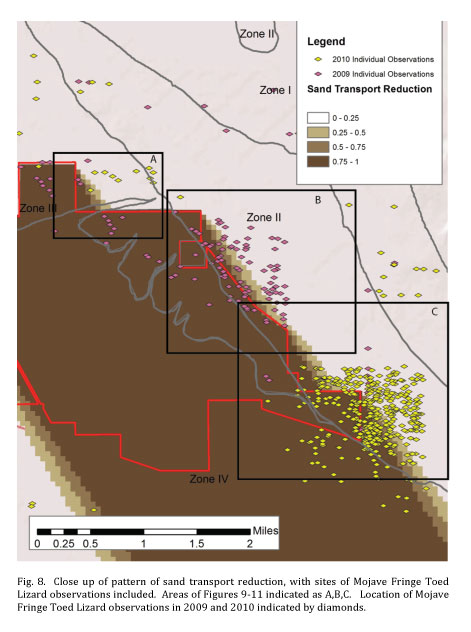
^Mojave fringe-toed lizard sightings mapped out against a model of how the solar project would block the sand transport corridor in the valley, shown as a brown "shadow" of the project and downwind blockage of sand flow.
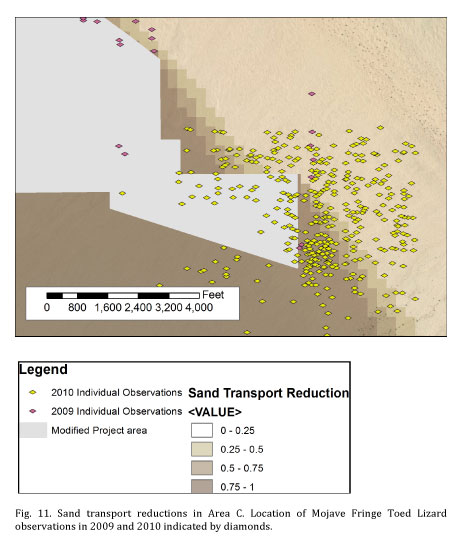

Furthermore, Mojave fringe-toed lizards (MFTL) will be killed by road work, blading of desert, and truck transport on new roads in the desert, as has already happened at a transmission line project nearby. Surveys along along the Colorado River Substation access road associated with the Devers to Palo Verde 2 (DPV2) transmission line project in 2012 and 2013 showed a mortality rate of one fringe-toed lizard killed per day in the project construction area. According to a memo by HELIX Environmental Planning Inc., monitoring commenced in October 2012 at a rate of 6 days per week and ended in November 2012 when fringe-toed lizards were no longer active. Monitoring re-commenced in April 2013 at a rate of 5 days per week and ended in June 2013 when construction was
completed in this portion of the project. HELIX relocated a total of 304 MFTL (40 in fall 2012 and 264 in spring/summer 2013) and recorded 90 MFTL mortalities (9 in fall 2012 and 81 in spring/summer 2013) during the two seasons of monitoring. In fall 2012, a total of 29 days of monitoring were conducted, which resulted in an average of 1.4 MFTL relocated/day and 0.3 MFTL mortalities/day. In spring 2013, a total of 61 days of monitoring were conducted, which resulted in an average of 4.3 MFTL relocated/day and 1.3 MFTL mortalities/day.
^ Details of a large map by HLEIX Environmental Planning, showing Mojave fringe-toed lizard surveys and mortality along the Devers-Palo Verde 2 500 kilovolt transmission line construction project.
Mortality of fringe-toed lizards is cumulatively building higher and higher in the Chuckwalla Valley due to this and other transmission line projects, associated substations, the Genesis solar project, Desert Sunlight and Desert Harvest solar projects, and the Palen solar project proposal.
A few desert tortoise (Gopherus agassizii) burrows, a few live individuals, a burrowing owl (Athene cunicularia), and tracks and sign of burro deer (Odocoileus hemionus eremicus, a desert-dwelling race of mule deer) were found during spring surveys of the proposed gen-tie line and natural gas pipeline that would serve the solar project. Kit fox burrow complexes were mapped.
California Energy Commission Releases the Latest Environmental Review Document
June 30, 2013 - The California Energy Commission released its Preliminary Staff Assessment on an agressive schedule to meet deadlines sought by BrightSource Energy for its design change since taking over this project from bankrupt Solar Millennium. The PSA reviews the project change from a solar thermal trough design to power towers. Updated surveys for natural resources present on the site are also included.
The California Energy Commission has generously given the public a whopping 30 days to comment on the 1,367 page Preliminary Staff Assessment reviewing the proposed BrightSource Energy Palen Solar Power Project, which would construct two solar power towers on about 5 square miles of federal land. The project will impact birds, rare desert sand dune habitat, desert tortoise, archeology sites and be visible from the wilderness of Joshua Tree National Park. The expedited schedule will help BrightSourc Energye meet financing deadlines at the expense of valuable public resources. If you would like to help us, write the California Energy Commission at docket@energy.ca.gov and request that “the comment period for the Preliminary Staff Assessment be extended an additional 60 days to provide adequate time to review the 1,367 page document.”
This notice is to inform you that the California Energy Commission (Energy Commission) staff has prepared a Preliminary Staff Assessment (PSA). The PSA contains the Energy Commission staff's independent evaluation of the proposed Palen Solar Electric Generating System (PSEGS) amendment. The PSA is now available for public review and comment. Under its certified regulatory program, Energy Commission staff has completed an independent assessment of the PSEGS Petition to Amendment (09-AFC-7C). The Energy Commission staff's preliminary conclusions are summarized in this notice. The Energy Commission encourages public participation in the review of the PSEGS Amendment (09-AFC-7C). The public comment period for this PSA begins now and will
continue for 30-days until 5:00pm on July 29, 2013.
See the CEC website under Compliance Documents: http://www.energy.ca.gov/sitingcases/palen/compliance/index.html
Palen Solar Project Status Report
June 11, 2013 - Thanks to Chris Clarke at KCET ReWire for this summary of the latest meeting with the California Energy Commission on BrightSource Energy's Palen Solar Electric Generating System project >>here.
BrightSource, Abengoa Partner on Palen Project
March 20, 2013 - On July 11, 2012, the California Energy Commission approved a petition from Palen Solar I, LLC to transfer the ownership of the Palen Solar Project, from Palen Solar I, LLC to BrightSource Energy, Inc.
This week BrightSource announced it will be partnering with Abengoa (a Spanish company) to construct the 500-MW Palen Solar Electric Generating System.
The two solar thermal companies will work together to permit and finance the project, and Abengoa, as the engineering, procurement and construction contractor, will build it. BrightSource wants to have Palen in commercial operation by June of 2016 in order to qualify for federal solar tax credits that expire at the end of 2016. BrightSource acquired the project last year during the bankruptcy proceeding of former owner Solar Millennium.
The project will consist of two solar power towers with superheated steam to turn steam turbines, with a natural gas powered back-up. BrightSource has requested re-alignment of a natural gas pipeline lateral to the project.
Current project (March 2013):
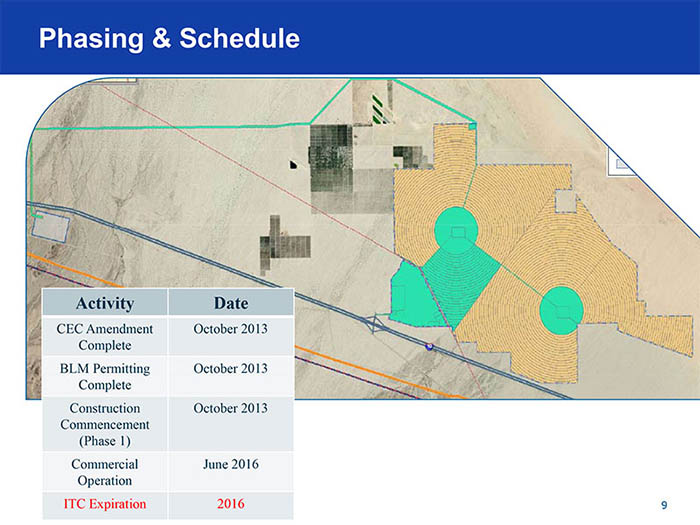
^BrightSource solar power tower project, from PDF PowerPoint on CEC website >>here.
Former Solar Millennium parabolic trough project (early 2012):
^One of two proposed alternatives favored by Solar Millennium to get out of the sand transport corridor (orange-yellow-green bands). (From CEC Revised Staff Assessment)
Solar Trust of America Files for Chapter 11
April 2, 2012 - See story >>here.
Solar Millennium Considers Switching Project to PV
August 25, 2011 - Solar Millennium AG may change the design of its solar thermal plants planned for the US, Manager Magazin reported, citing an unidentified company spokeswoman. Erlangen, Germany-based Solar Millennium is considering switching plants in the Amargosa Valley near Las Vegas, and the Palen Solar Power Project in Riverside County, California to photovoltaic generation, the magazine said, citing the spokeswoman.
The company has already redesigned their Blythe Solar Power Project and Ridgecrest Solar Power Project from solar thermal parabolic trough to photovoltaic.
Final Environmental Review Statement Out
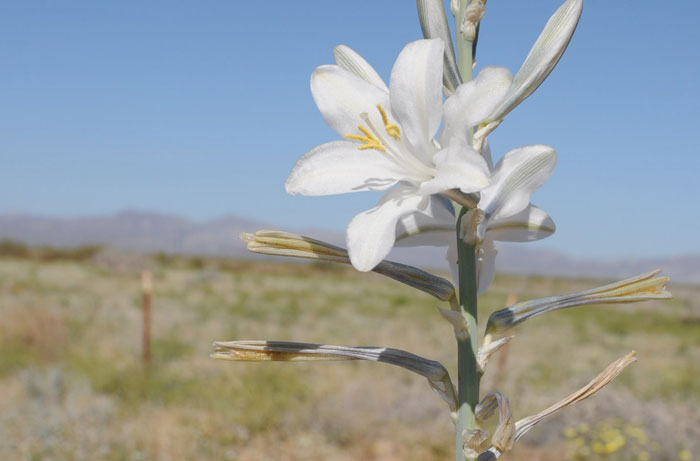
^Desert lily (Hesperocallis undulata) on the Palen project site.
May 15, 2011 - The Bureau of Land Management (BLM) on May 13 released the Final Environmental Impact Statement (FEIS) for the Palen Solar Power Plant project in Riverside County, California.
Palen Solar I, LLC (Palen), a wholly owned subsidiary of Solar Millennium, Inc., has requested a right-of-way authorization to construct and operate the proposed project on approximately 5,200 acres of public lands 10 miles east of Desert Center. The proposed project would construct a 500-megawatt concentrating solar energy generating facility, as well as a transmission line and associated facilities. The project would connect to the planned Red Bluff substation, which would connect the project to the Southern California Edison regional transmission grid.
The BLM's preferred alternative in the FEIS is a modified footprint alternative that includes an optional 240 acres of private land at the south end of the project. The preferred alternative would also include an amendment to the California Desert Conservation Plan. The FEIS analyzes three action alternatives, a no-action alternative and two no-project alternatives that would amend the CDCA Plan. If approved, construction would begin in late 2010.
The FEIS/Proposed CDCA Plan Amendment analyzes the site-specific impacts on air, soil, water, cultural and biological resources as well as land use, noise, visual resources and impacts on Joshua Tree National Park.
Publication of the FEIS and proposed plan amendment initiates a 30-day comment period on the FEIS and a 30-day protest period on the proposed plan amendment. Details on filing a protest can be found in the Federal Register Notice and in the FEIS, both of which are available on the project website, www.blm.gov/ca/st/en/fo/palmsprings/Solar_Projects/Palen_Solar_Power_Project_2.html.
For more information please refer to the project website, or contact Allison Shaffer, BLM project lead, (760) 833-7100 or CAPSSolarPalen@blm.gov. Comments may be faxed to (760) 833-7199, or mailed to Allison Shaffer, Project Manager, Palm Springs South Coast Field Office, BLM, 1201 Bird Center Drive, Palm Springs, CA 92262.
Energy Commission Approves Project

^Project site.
December 15, 2010 - Today the California Energy Commission approved the 500-megawatt Palen Solar Power Project as well as the Rice Solar Energy Project, the smaller power tower at 150 MW. Center for Biological Diversity did a good job of opposing Palen, making a convincing case that CEC violated both the California Environmental Quality Act and their own Warren-Alquist Act, such as approving two project alternatives that Solar Millennium gets to choose from later. Also, parts of the Palen project are in two Wildlife Habitat Management Areas designated by Bureau of Land Management in their North Eastern Colorado Desert Plan, and part in a Desert Wildlife Management Area for tortoise habitat. BLM legally would need to approve a plan amendment to allow energy uses in these areas, and they do not even have a Final Environmental Impact Statement yet out for the project.
CEC summarily dismissed all these arguments.
We brought up the concerns that two prehistoric trails described by archaeologists cross and join on the project site, one from the Mule Mountains and one from the Palen Mountains, both going to the life-giving waters of Corn Springs across the valley to the south. Native people have long known of these trails and decry the destruction of these valuable cultural resources. BLM and CEC seem to ignore these features.
Also, groundwater pumping by the project would admittedly lower water tables, yet no analysis was done of the large Desert ironwood tree groves (Olneya tesota) in the region, and whether they would be impacted.
Plus the project would still directly impact much Mojave fringe-toed lizard (Uma scoparia) habitat. No assurance was given that private land-owners in Chuckwalla Valley who own sand habitats with the lizard would be willing to sell for mitigation lands.
Nevertheless, CEC attorneys tried to shoot down these arguments (in a manner that was not convincing), and the five Commissioners quickly voted to approve the project, adopting the Presiding Member's Proposed Decision.
One Commissioner brought up how Governor-elect Jerry Brown did indeed want a much more aggressive Distributed Generation goal of 12,000 MW (such as rooftop solar panels), but he still wants 8,000 MW of utility-scale solar, so "we have to approve this one," because Brown wants both. Also the usual overrides of biology, visual, and other resource concerns because of the urgency of climate change, the Great Recession that we are in, jobs needed, and "public convenience and necessity."
Energy Commission Recommends Approval
November 12, 2010 - Proposed Decision Recommends License for Palen Solar Power Project
SACRAMENTO - A California Energy Commission siting committee is recommending approval of the planned Palen Solar Power Project in Riverside County.
In its presiding member's proposed decision (PMPD) released today, the committee recommended either of two alternatives for the 500-megawatt facility that would eliminate impacts on biological resources. The project, even with mitigation measures, will contribute to direct environmental impacts to visual resources and to cumulative
environmental impacts in the areas of cultural resources, visual resources, and land use. However, the benefits of the project would outweigh, and justify a legal override of, those impacts. In addition, the committee determined that the project complies with all applicable laws, ordinances, regulations, and standards.
The PMPD is not a final decision on the project. The committee released the document for 30 days of public comment and will consider input before bringing the proposed decision to the full five-member Commission. The entire document can be found on the Commission's website at:
http://www.energy.ca.gov/sitingcases/solar_millennium_palen/documents/
Palen Solar I, LLC, a subsidiary of Solar Millennium, LLC, is the applicant for the Palen Solar Power Project. The project would be located about 10 miles east of Desert Center and about halfway between the cities of Indio and Blythe in eastern Riverside County.
A right-of-way grant is being sought for approximately 5,200 acres of land managed by the federal Bureau of Land Management. Originally, construction and operation of the 500-MW project would have taken up about 2,970 acres.
The two alternatives recommended in the PMPD reconfigured the project to significantly reduce impacts on the Mojave fringe-toed lizard, sand dune habitat, and sand transport corridor. One alternative disturbs 4,365 acres, while the other alternative would take up about 4,330 acres.
The project is a concentrating solar trough thermal electric generating facility with two adjacent and independent units of 250 megawatts each for a total capacity of 500 megawatts. The proposed project would use parabolic trough technology where parabolic mirrors are used to heat a transfer fluid which is then used to generate steam. Electricity is produced from the steam expanding through steam turbine generators.
The Palen Solar Power Project is among nine large solar thermal projects scheduled to go before the full Commission before the end of the year. More than 4,100 megawatts of solar power will be added if all nine projects are approved.
The seven plants that have already have been licensed are: 250-MW Abengoa Mojave Solar Project (Sept. 8); the 250-MW Beacon Solar Energy Project (Aug. 25); the 1,000-MW Blythe Solar Power Project (Sept. 15); 663.5-MW Calico Solar Project (Oct. 28); the 250-MW Genesis Solar Energy Project (Sept. 29); the 709-MW Imperial Valley Solar Project (Sept. 29); and the 370-MW Ivanpah Solar Electric Generating System project (Sept. 22).
The federal government and the State of California have established the need to increase the development and use of renewable energy in order to enhance the nation's energy independence, meet environmental goals, and create new economic growth opportunities.
More information on the proposed project is at:
http://www.energy.ca.gov/sitingcases/solar_millennium_palen/
Phreatophytes Not Ignored
September 27, 2010 - During a California Energy Commission workshop, Solar Millennium emphasized that it had pulled its project out of a large sand transport corridor along the northern part of the project area (see map above), where Mojave fringe-toed lizards (Uma scoparia) and many rare alkaline-sand-adapted rare plants dwell.
The California Energy Commission agreed that this would lessen the impact to the lizard to less than significant levels, although we still beleive impacts to the sand lizard will be huge. The area will be heavily disturbed, and predators such as Loggerhead shrikes will have more fenceline perches to nab the lizards. The project vivinity may become a sink for the local population.
But at the workshop, the Energy Commission botanist Carolyn Chaney Davis was most concerned about groundwater pumping to phreatophytes, arid-adapted trees with deep roots to access groundwater. Honey mesquite groves (Prosopis glandulosa) surround much of Palen Dry lake about a mile from the proposed project. Other deep-rooted desert trees in the area include Ironwood (Olneya tesota), blue palo verde (Parkinsonia florida), and smoke tree (Psorothamnus spinosus).
A special plan community, the Alkali Sink Scrub, is even more endangered because the shrubs have shallower roots. This community is dominated by Iodine bush (Allenrolfea occidentalis) and Bush seepweed (Suaeda moquinii). These are wetland indicators of playa depressions with a shallow aquifer.
Scientists are not sure of the tolerance of these plants to chasing a lowering groundwater table down. Many phreatophytes have a dimorphic root system, with a shallower root area that can absorb brief rain runoff, and a deep root system to tap into groundwater during most of the year.
Hours were spent during the workshop in a debate between Solar Millennium and CEC, as Chaney Davis wanted a monitoring program to be carried out to see whether the Palen Solar Power Project's well's would impact the trees and alkali scrub nearby. Solar Millennium argued that the dry lake where the phreatophytes and alkali scrub grew was on a shallow perched water table in a playa clay layer, that was completely unconnected to the 150-foot deep groundwater on the alluvial fan under their project site, there fore they could not possibly draw down water in the plant communities of cenocern. Chaney Davis responded that the hydrology was speculative and she wanted monitoring as part of the project's certification. These valuable desert communities have been long ignored, and this time she wanted studies to see if the trees died over the next 30 years.
Solar Millennium said they did not want to be solely responsible for a few trees dying, as this could be due to the nearby agricultural wells. And putting in monitoring boreholes would only make financing the project more difficult, with added costs building up. CEC wanted to err on the side of caution, however. The issue was not resolved, and will be brought up again in further workshops.

^Honey mesquite at Palen Dry Lake.
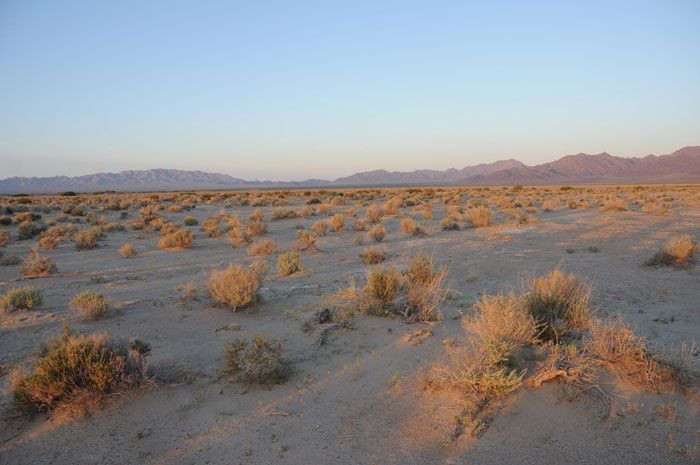
^Alkali Sink Scrub at Palen Dry lake.
See Concern over spread of Sahara Mustard at the Blythe Solar Power Project >>here.
Cultural Issues Addressed in Video
July 29, 2010 - La Cuna de Aztlán (With Updated Comments By Chemehuevi Tribal Chairman, Charles Wood), video by Robert Lundahl. http://www.vimeo.com/13650564
June Site Visit Report
April Site Visit Report
Draft EIS Out
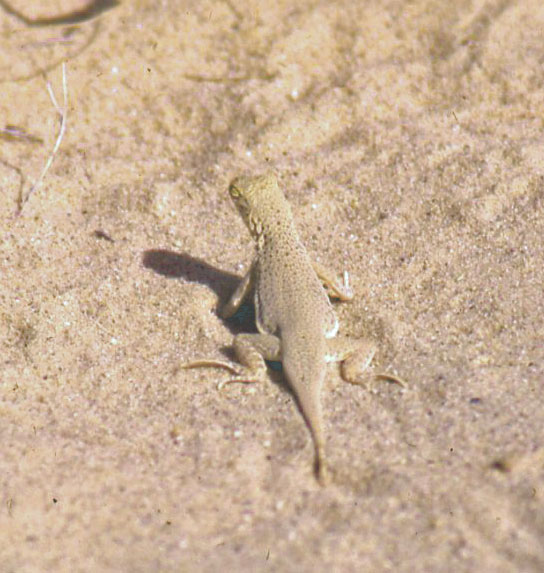 March 19, 2010 - From the Staff Assessment/Draft Environmental Impact Statement for the Palen Project "1,735 acres of Mojave fringe-toed lizard habitat would be eliminated". The California Energy Commission and Bureau of Land Management have estimated in its joint document that big solar will destroy 16 percent of all fringe-toed lizard habitat in the California Deserts. Members of Basin and Range Watch were on the site March 16, 2010, and we can confirm that this species is abundant there...well, not for much longer.
March 19, 2010 - From the Staff Assessment/Draft Environmental Impact Statement for the Palen Project "1,735 acres of Mojave fringe-toed lizard habitat would be eliminated". The California Energy Commission and Bureau of Land Management have estimated in its joint document that big solar will destroy 16 percent of all fringe-toed lizard habitat in the California Deserts. Members of Basin and Range Watch were on the site March 16, 2010, and we can confirm that this species is abundant there...well, not for much longer.
Mojave Fringe-toed Lizard (Uma scoparia)
The SA/DEIS states: "The PSPP would eliminate 1,735 acres of Mojave fringe-toed lizard habitat in the northeastern portion of the Project Disturbance Area, an area of active wind-blown sand with relatively shallow sand deposits, as well as areas of deeper and more active
vegetated sand dunes. In addition to this direct and immediate loss of habitat, the
project would significantly affect downwind Mojave fringe-toed lizard habitat (see Soil &
Water Appendix A). The northeastern portion of the Project interrupts the regional
wind-borne sand transport corridor that moves sand southeast and east along the
Chuckwalla Valley and toward the Colorado River (Soil & Water Appendix A, Solar
Millennium 2010a).
"Staff considers the direct, indirect, and cumulative direct effect of the Project to be
significant for the Chuckwalla Valley Mojave fringe-toed lizard population. The
cumulative impact of all the proposed projects would be to increase the already
fragmented distribution of the Mojave fringe-toed lizards, and to increase the risk of
extirpation of isolated populations within the Chuckwalla Valley. Staff's proposed
Condition of Certification BIO-20 recommends acquisition and protection of core
populations of Mojave fringe-toed lizard habitat elsewhere in the Chuckwalla Valley.
Habitat acquisition would offset some of this habitat loss, although not to less than
significant levels, and cannot remedy the Project's interference with the sand transport
process. Staff considers impacts of the Project, as currently configured, to be significant
and unmitigable."
Fringe-toed lizards have been reduced or eliminated from small dune systems from off-road traffic and urban development in other areas, now this new threat faces these interesting lizards. (See also our story on Calico Solar 1 habitat >>Sand Lizards.)
Joint Staff Assessment/Environmental Impact Statement Released for Palen Solar Project in Riverside County
Released: March 18, 2010
The project is being jointly developed by Solar Millennium, LLC, and Chevron Energy Solutions.
The 484-megawatt facility, to be located near Palen Dry Lake in Riverside County. The project will utilize solar parabolic trough technology to generate electricity. With this technology, arrays of parabolic mirrors collect heat energy from the sun and refocus the radiation on a receiver tube located at the focal point of the parabola. A transfer fluid is heated (dangerous Therminol) to approximately 750 degrees Fahrenheit as it circulates through the receiver tubes, then piped through a series of heat exchangers where it releases stored heat to generate high-pressure steam. The steam is fed to a traditional steam turbine generator where electricity is produced. The 5,200 acre project site is located approximately 10 miles east of Desert Center, along Interstate 10, approximately halfway between the cities of Indio and Blythe in Riverside County.
For additional details on the Palen Solar Project SA/DEIS, click on:
http://www.energy.ca.gov/sitingcases/solar_millennium_palen/
Chevron Energy Solutions/Solar Millennium Palen Solar Power Plant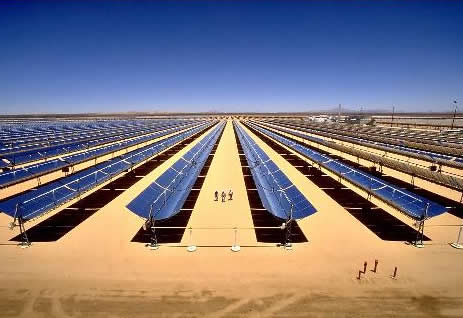
The Palen site is 10 miles east of Desert Center, California and a half mile north of Interstate 10. The proposed Palen Solar Power Project would consist of two parabolic trough solar thermal power plants, each of which would have a solar field comprised of rows of parabolic mirrors focusing solar energy on collector tubes. The tubes would carry heated oil to a boiler, which would then send steam to a turbine. The two phases would generate approximately 484 MW of electricity. The two power plants would share administrative buildings, parking areas, maintenance buildings, switch yards, bioremediation areas, wastewater treatment facilities, access and maintenance roads, and perimeter fencing. The project would also include a natural gas pipeline, communication lines, and a 230 kV transmission line. The total expected project footprint would be approximately 3,800 acres. During construction, the project would require approximately 1,100 acre-feet of water for dust control and soil compaction. During operation, the project would require approximately 300 acre-feet of water per year. CESSM proposes to use water from new wells. The Palen facility would be constructed in two phases.
See:
http://www.energy.ca.gov/sitingcases/solar_millennium_palen/index.html
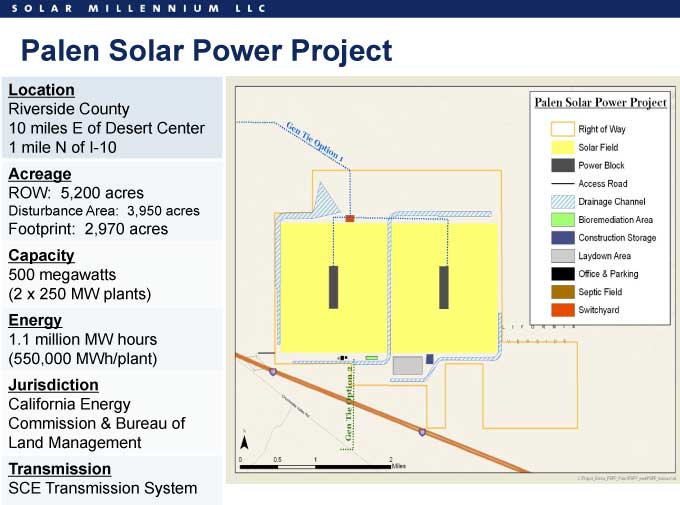
^Old version of project.
